Dozens of intricate lakes lie hidden in the Sayward Forest, just north-west of Campbell River on Vancouver Island. Twelve of these lakes align and connect with other waterways to form a convenient oval.
This is the basis of the 47km Sayward Forest Canoe Circuit. Not just for canoes, this route is perfect for a three to five day paddling adventure.
Case in point – Sayward was our first ever backcountry adventure and we were instantly hooked! We’ve since paddled the circuit again with more experience and it still holds up.
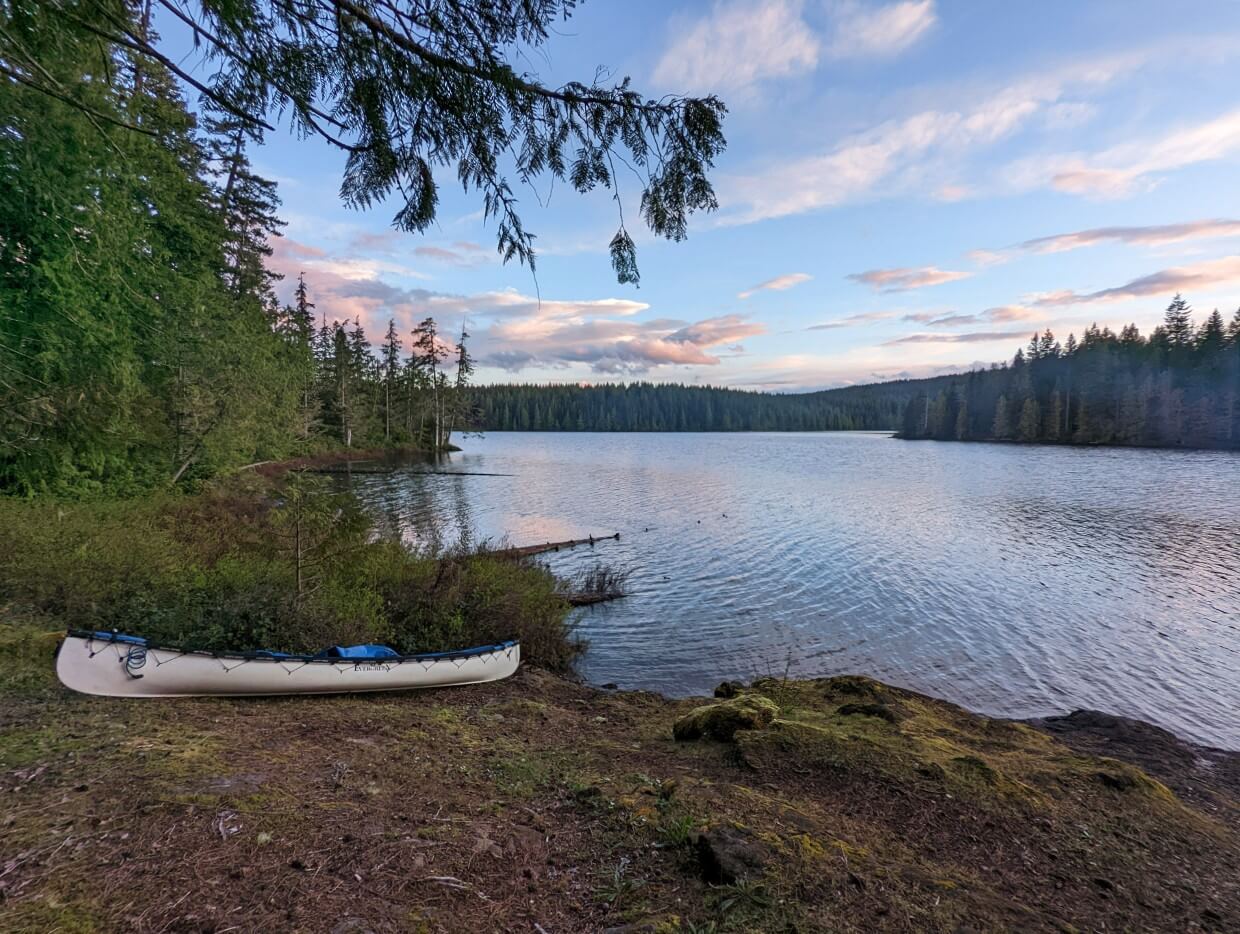
The Sayward Forest provides a variety of paddling experiences from long, narrow lakes to short river sections and tiny ponds. When conditions are calm, paddlers can enjoy beautiful mirror lake reflections.
Surrounded by lush temperate rainforest (with a few patches of old growth), some lakes are even backdropped by rugged mountains.

Read on to discover our complete paddling guide to the Sayward Forest Canoe Circuit on Vancouver Island. Paddling the route twice now, we’ve got some tips to share!
Here’s what to expect:
There are some affiliate links in this post. If you make a purchase via one of these links, we may receive a small percentage of the sale at no extra cost to you.
Backcountry necessities
- Always bring the 10 Essentials
- Know how to stay safe in the backcountry
- Remember to Leave No Trace to help keep the wilderness wild
- Understand how to avoid negative bear encounters
- Recommended camping gear is listed on our Shop page
- Sign up to our newsletter for a free paddling checklist

Introducing the Sayward Forest Canoe Circuit
The Sayward Forest Canoe Circuit features a continuous loop of lakes, waterways and portages on Vancouver Island.
Paddlers spend an average of three to five days transporting their canoe and camping gear in a counter clockwise direction around the circuit, finishing at the exact same place they started.
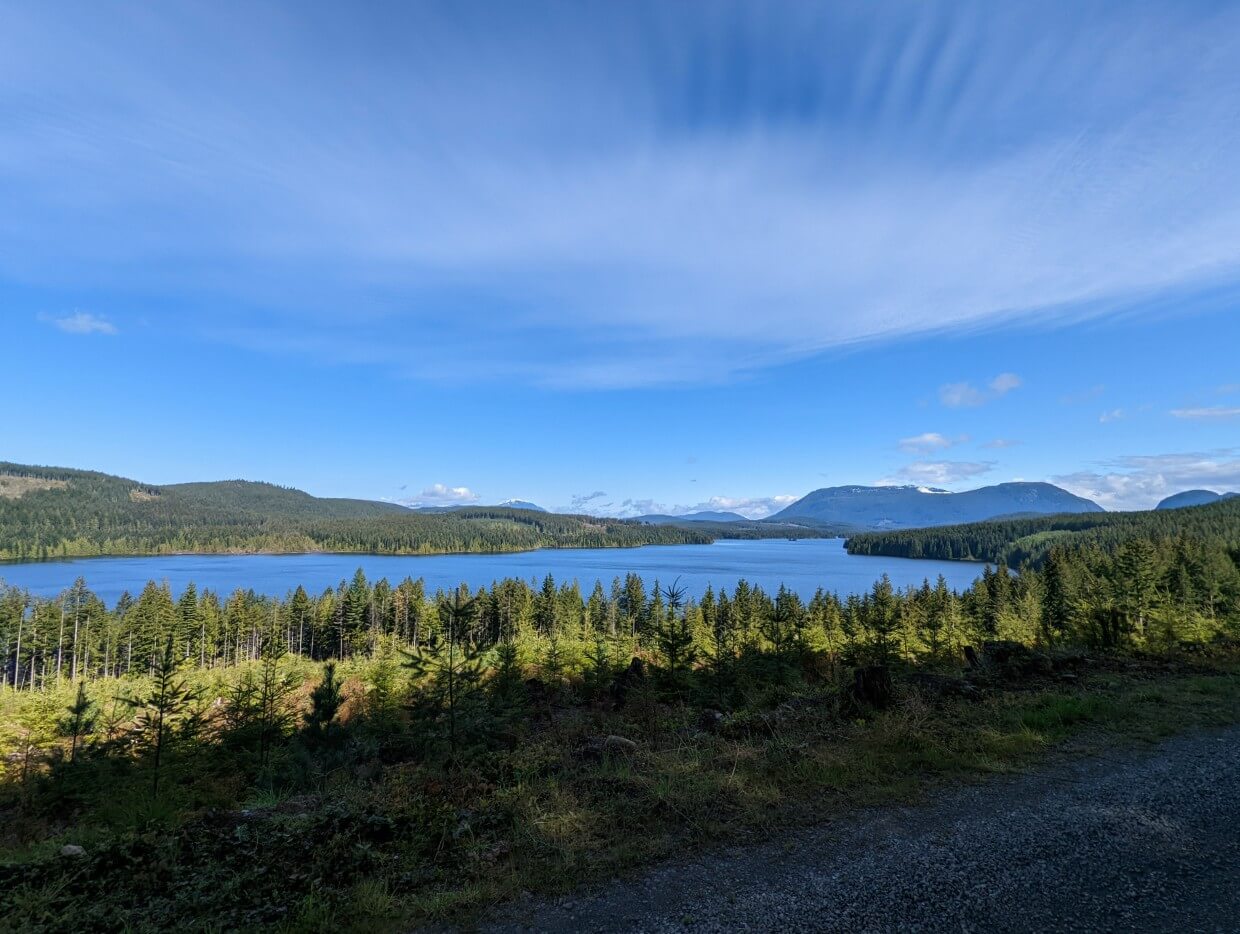
With beautiful views, well maintained facilities, a convenient location and just the right amount of challenge, the Sayward Canoe Circuit is a great choice for a paddling trip for novices and veterans alike.
The satisfaction of travelling around in a complete circuit with only human power is immeasurable.
This unique Vancouver Island paddling experience rivals other British Columbia canoe trips, including the famous Bowron Lake Canoe Circuit (we actually prefer the Sayward Forest!)

History of the Sayward Forest
The Sayward Forest Canoe Circuit is located on the traditional territory of the Wei Wai Kum, Homalco, We Wai Kai, Kwakwaka’wakw and K’ómoks people. These lakes are likely to have been used for travel for thousands of years.
Europeans began to settle in the Campbell River (Wiwek̓a̱m) area in the 1880s. A few decades later, logging started. Springboard notches from this time are still visible on some of the larger tree stumps along the portage routes.
The English name for this area originated from the logger and sawmill operator William Sayward.
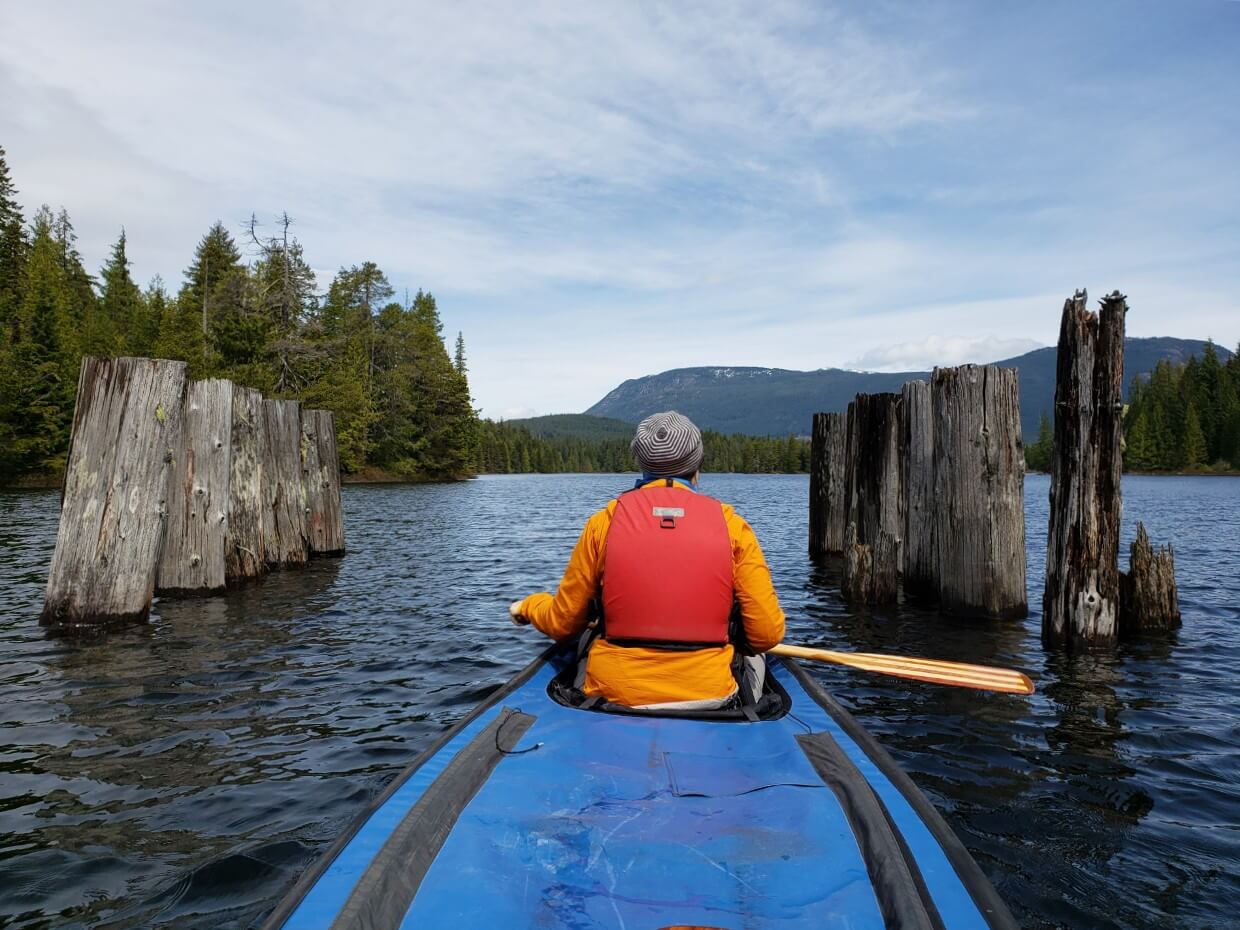
The forest was developed during the Depression era, with a number of work camps situated around the lakes (some of these are now Recreation Sites). Railways criss-crossed the lakes, transporting wood to the local mills.
In 1938, a huge fire destroyed 35,000 hectares of trees. This led to BC’s first planting project, during which 800,000 seedlings were planted within a single month. Replanting continues in the forest today, replacing the trees harvested by loggers.
Despite the easy access and amount of recreation opportunities as well as logging activity in the area, there is a surprising wilderness feel about the Sayward Forest.

The lakes are completely surrounded by second growth forest, with a few hidden groves of old growth. A few cut blocks are visible from the lake and there is some low level industrial noise here and there, but for the most part, it’s just you and the beauty of nature.
There’s a lot of amount of wildlife to look out for too, with beavers, bald eagles, elk and deer being regularly sighted.
This working forest may not be protected by provincial or national park boundaries, but it still offers an incredible wilderness experience.
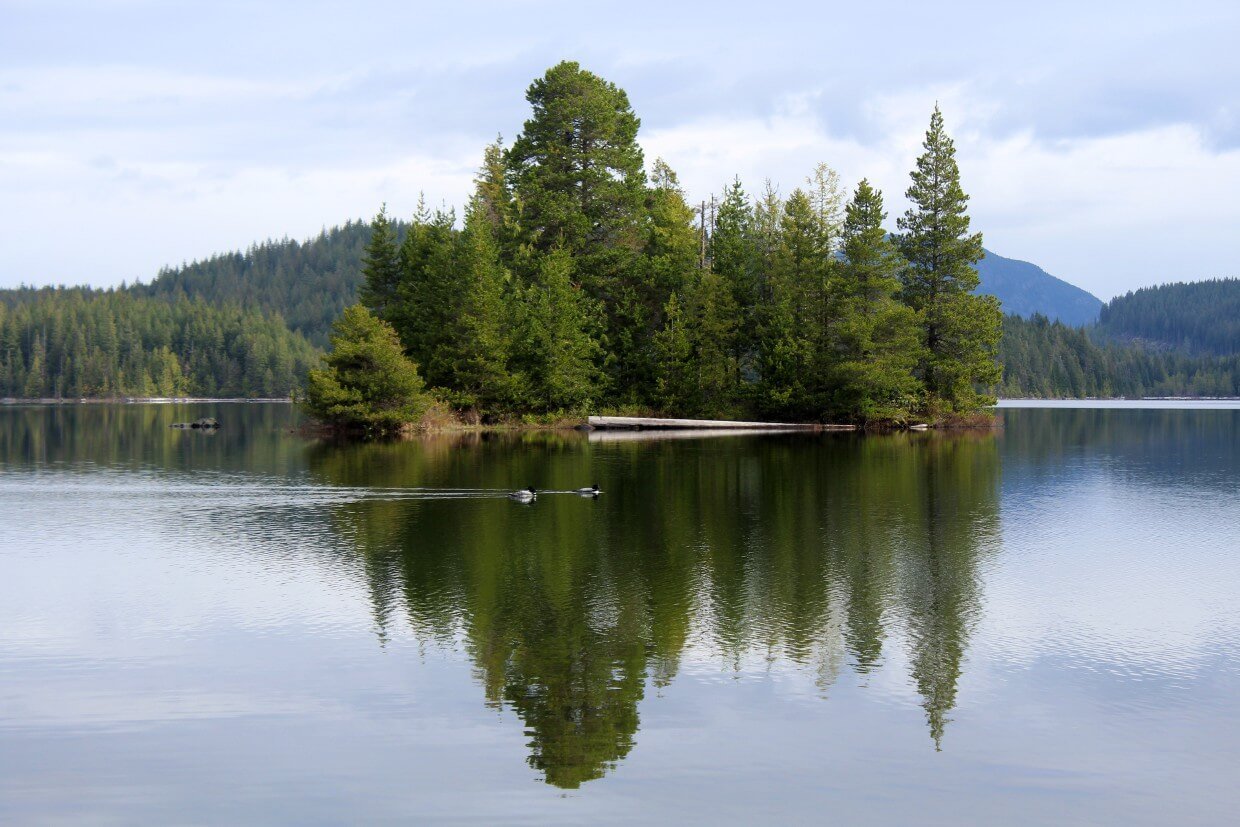
Quick facts about the Sayward Forest Canoe Circuit
- Approximately 39km of paddling, 8km of portage
- 12 lakes, 12 portages
- No circuit fees, reservations or registration required
- Lots of free campsites
- A mix of lakes, rivers, channels and ponds
- Easily accessible and a short drive (30km) via highway and logging roads from Campbell River
- Sites and Trails BC map available
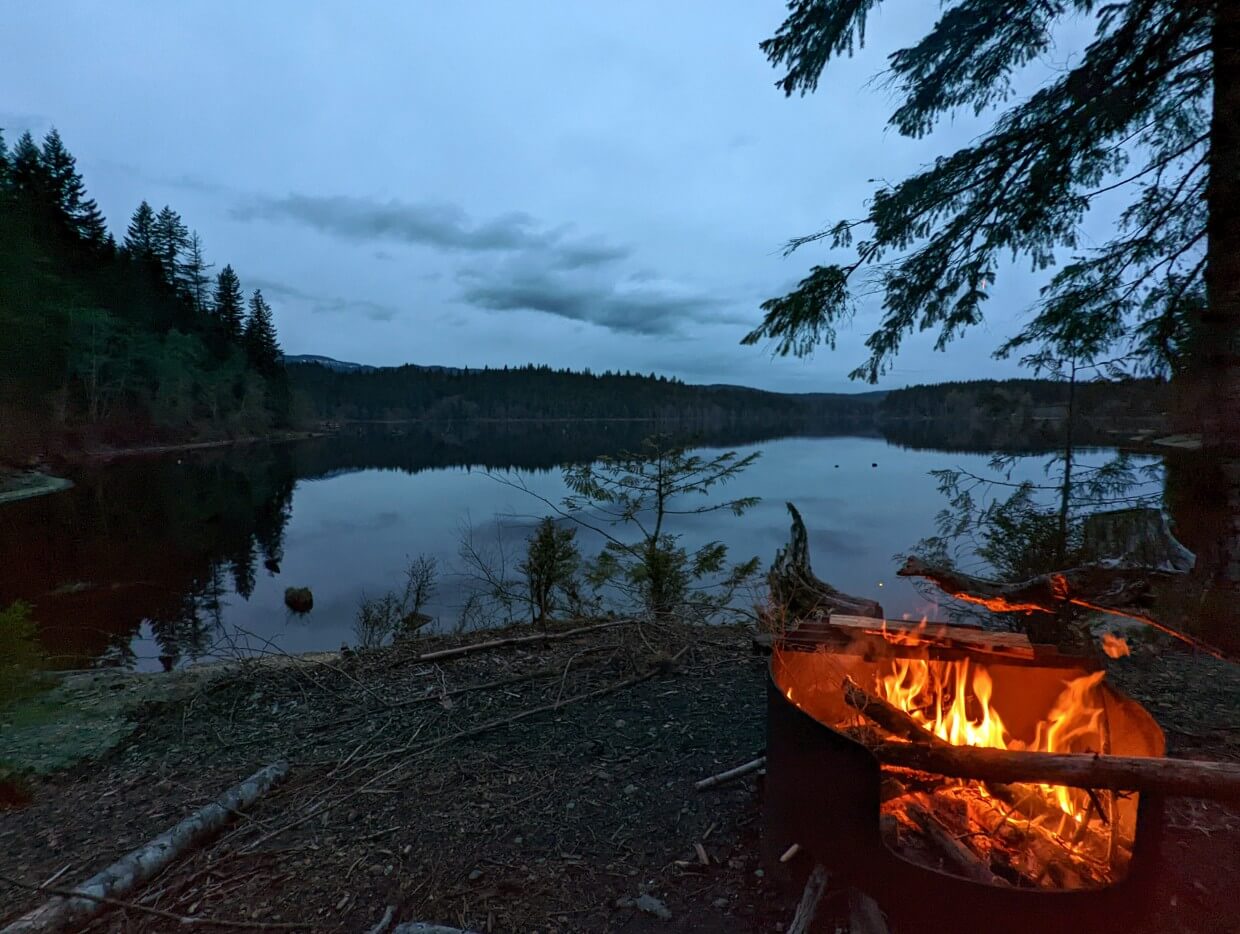
Our paddling experience on the Circuit
We have paddled the Sayward Forest Canoe Circuit twice – in June 2013 and May 2022.
June 2013
The first time, we launched at Apple Point Recreation Site on Brewster Lake and camped on Gray Lake, Goose Lake (Mohun North) and Amor Lake.
Neither of us had ever done any kind of multi-day outdoor adventure involving a different destination every day and a set route like this, so it was all pretty brand new and exciting for us.
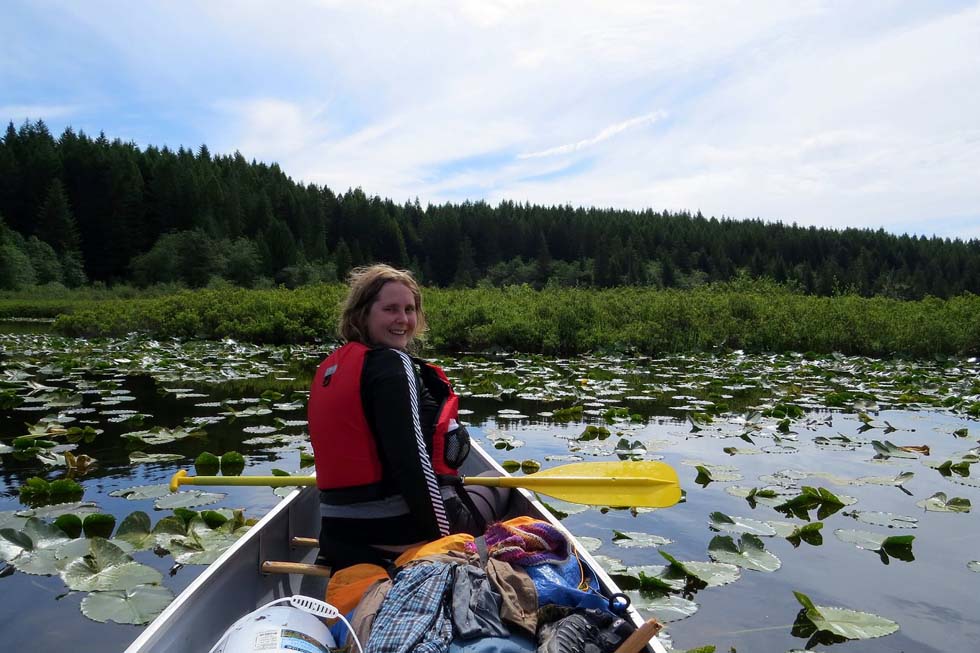
The Sayward Canoe Route lived up to our expectations and more. The experience wasn’t exactly a piece of cake for us (it rained a lot, the portages were harder than we anticipated) but we had an awesome time none withstanding.
Each lake was just a little bit different, with something new to look at around every corner. A new mountain, an island, an old railway trestle, a beaver dam in our intended path….we just loved it.

May 2022
We recently returned to the circuit to see how much nine years had changed the Sayward Forest (and us!)
This time, we launched at Morton Lake Provincial Park and camped on Amor Lake, Fry Lake and Mohun Lake (Mohun Island). The experience was both similar and different.
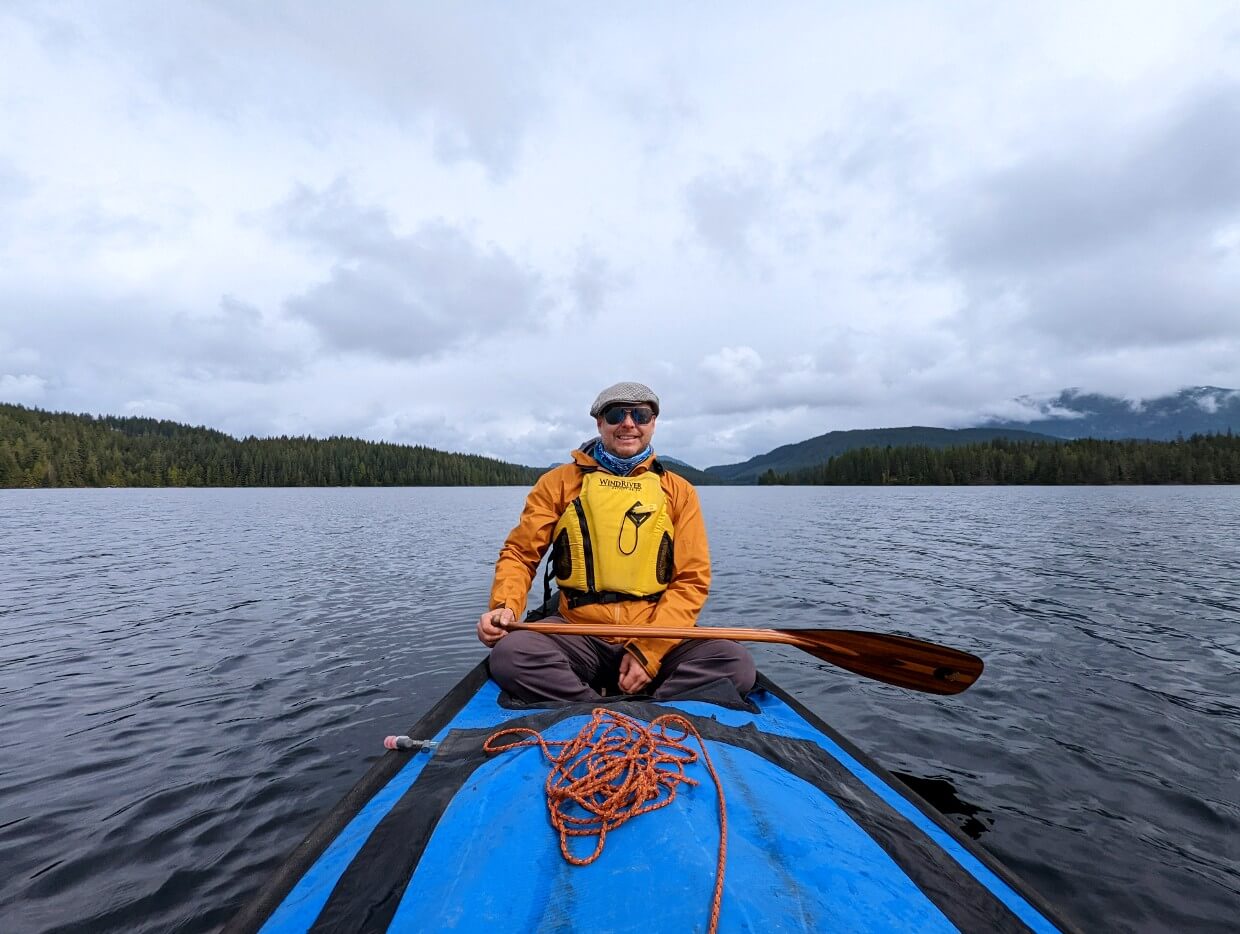
The circuit signage and campsite facilities were better. We noticed more portage rests but saw the same amount of people (very few). The portages were not quite as hard as before, with the help of a canoe cart and lighter equipment.
The high water levels swallowed some of the beach campsites and quickened our progress on the river. High winds saw us surfing metre-high swells on Lower Campbell Lake.
It was just as fun. Better even, in some ways. The ‘newness’ of the adventure was gone but the Sayward Forest was still as beautiful as we remembered.
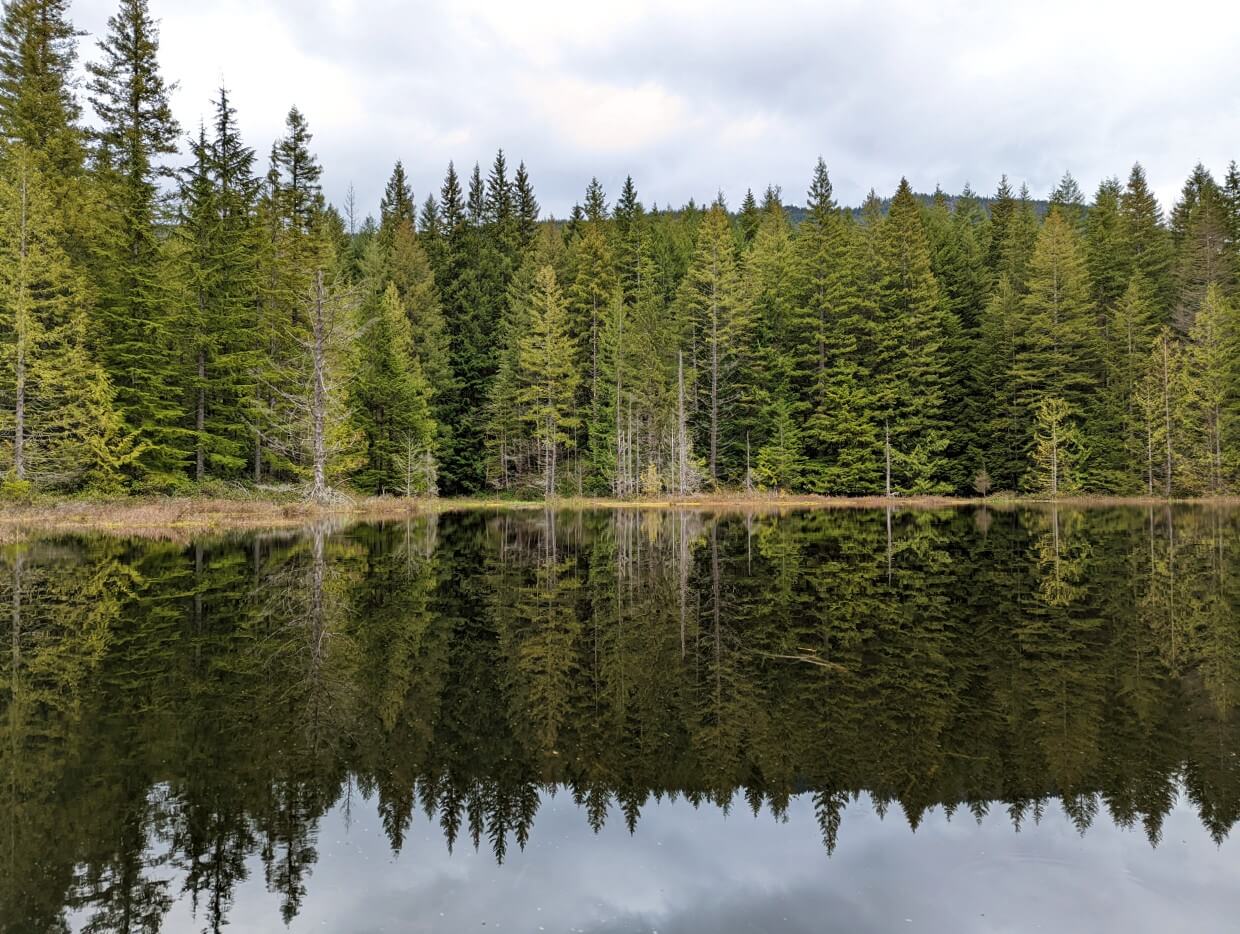
Sayward Forest Canoe Circuit paddling guide
Inspired to paddle the Sayward Forest Canoe Circuit yourself? This section features all of the essential details you need to know to plan your adventure.
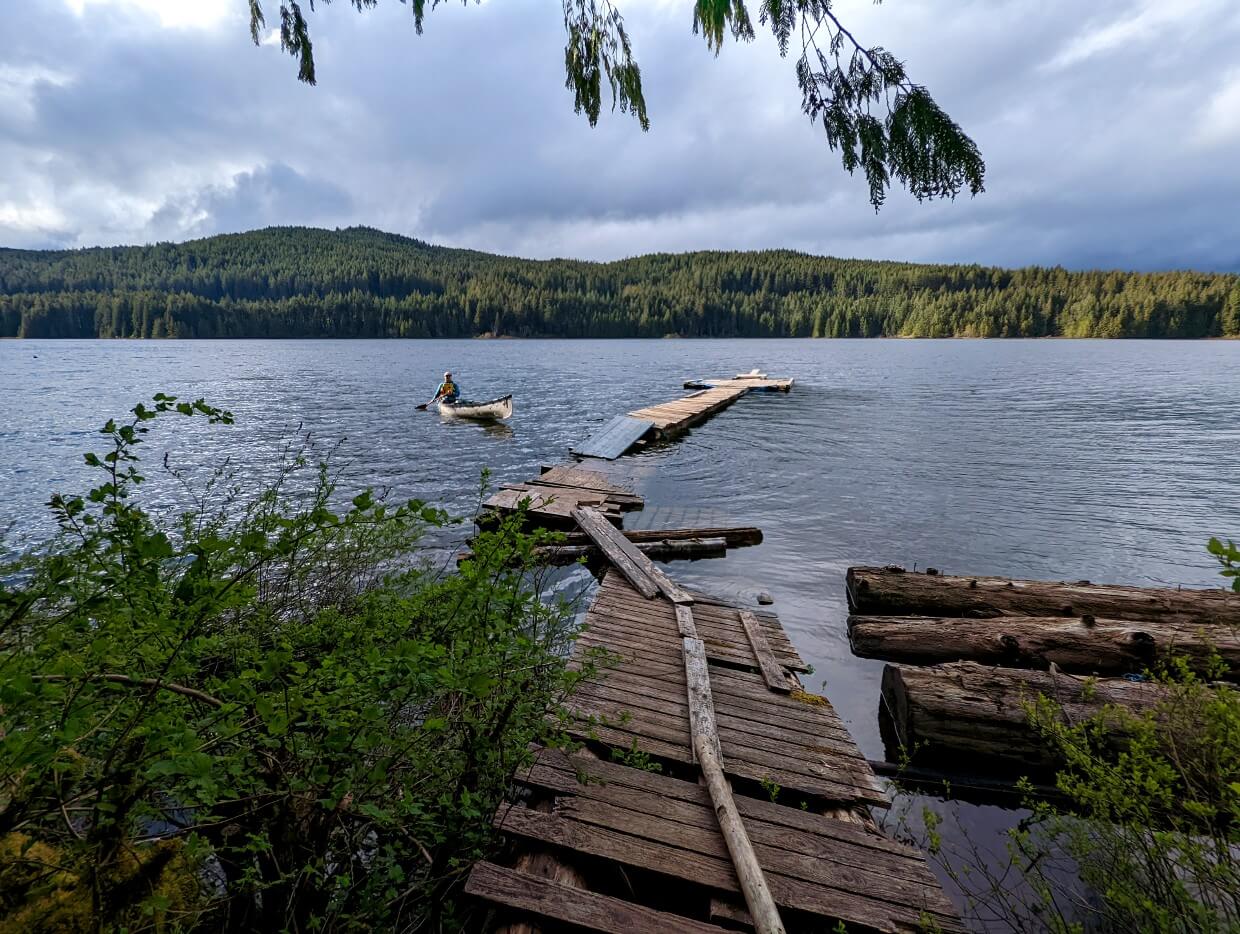
Location
The Sayward Forest Canoe Circuit is located north-west of Campbell River on Vancouver Island, British Columbia, Canada.
Though relatively close to civilisation and well used by campers and fishermen, the Sayward Forest is not widely known beyond local recreationalists. It is often confused with the village of Sayward (pop. 300), which is situated another 70km north.
Campbell River is the closest city to the Sayward Forest, accessible via Highway 19 and Highway 19A from Courtenay, Nanaimo and Victoria.
BC Ferries offers multiple ferry connections between the British Columbia mainland to Vancouver Island. The closest ferry terminal to the Sayward Forest is Departure Bay in Nanaimo, a 90 minute (150km) drive to the south.
If you’re bringing your own canoe to paddle the circuit, keep in mind that there is less available space for oversized vehicles on the ferry. Arrive early or consider making a reservation to guarantee a spot on a specific crossing.
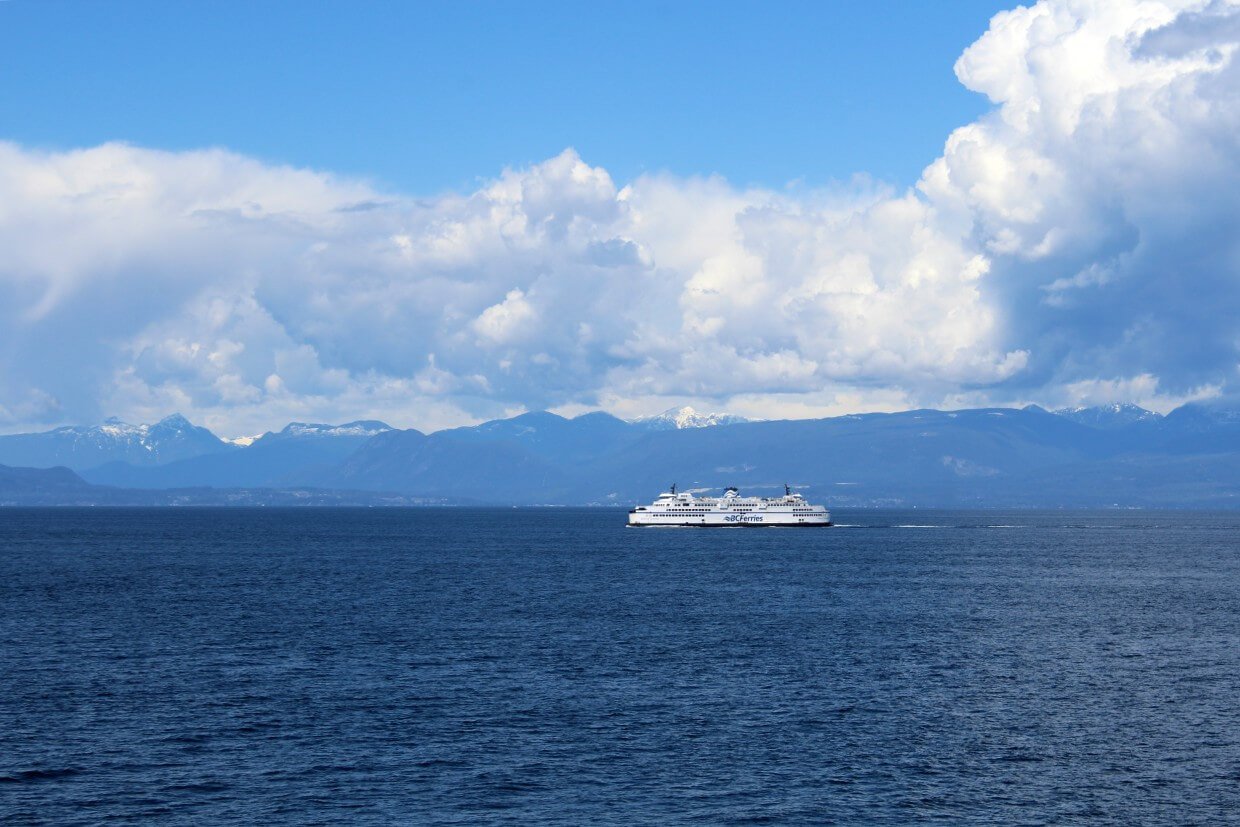
When to go
Situated at fairly low elevation on mild Vancouver Island, this canoe circuit can technically be paddled year round.
But speaking practicality, the main paddling season for the Sayward Forest Canoe Circuit is May to October.
July and August are the most popular months, with the warmest weather experienced. There are some downsides, however.
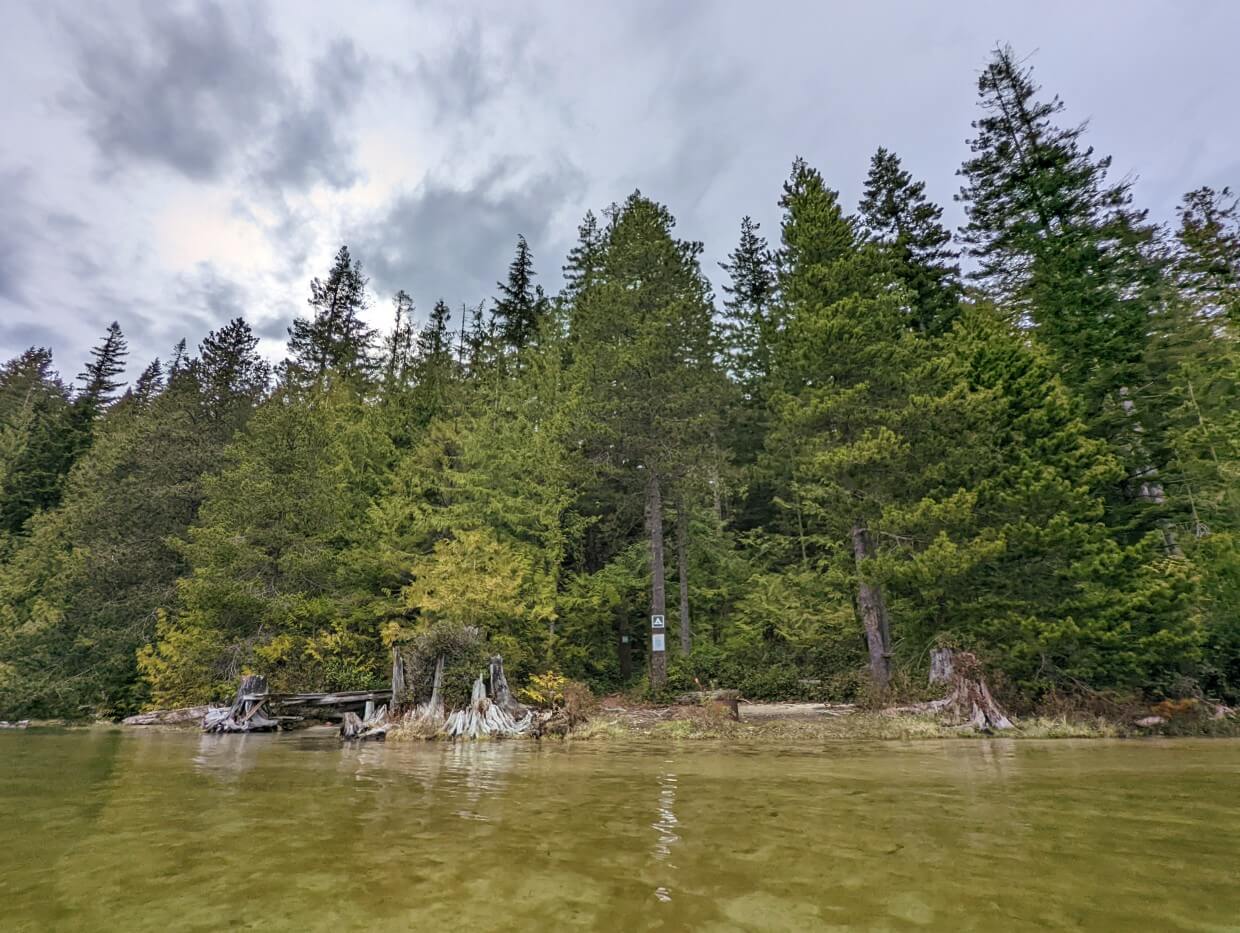
The vehicle-accessible campgrounds surrounding the circuit also see the most usage during this time. Not only does this mean less space in campgrounds, but more boats and less peace on the lakes.
As the summer continues, water levels on the lakes decrease. Paddlers will have to line their canoes for longer stretches on the two river sections on Whymper Creek.
For these reasons, June and September are favoured alternatives. The campgrounds and lakes are less busy and the weather is still warm. The fishing is generally better too.
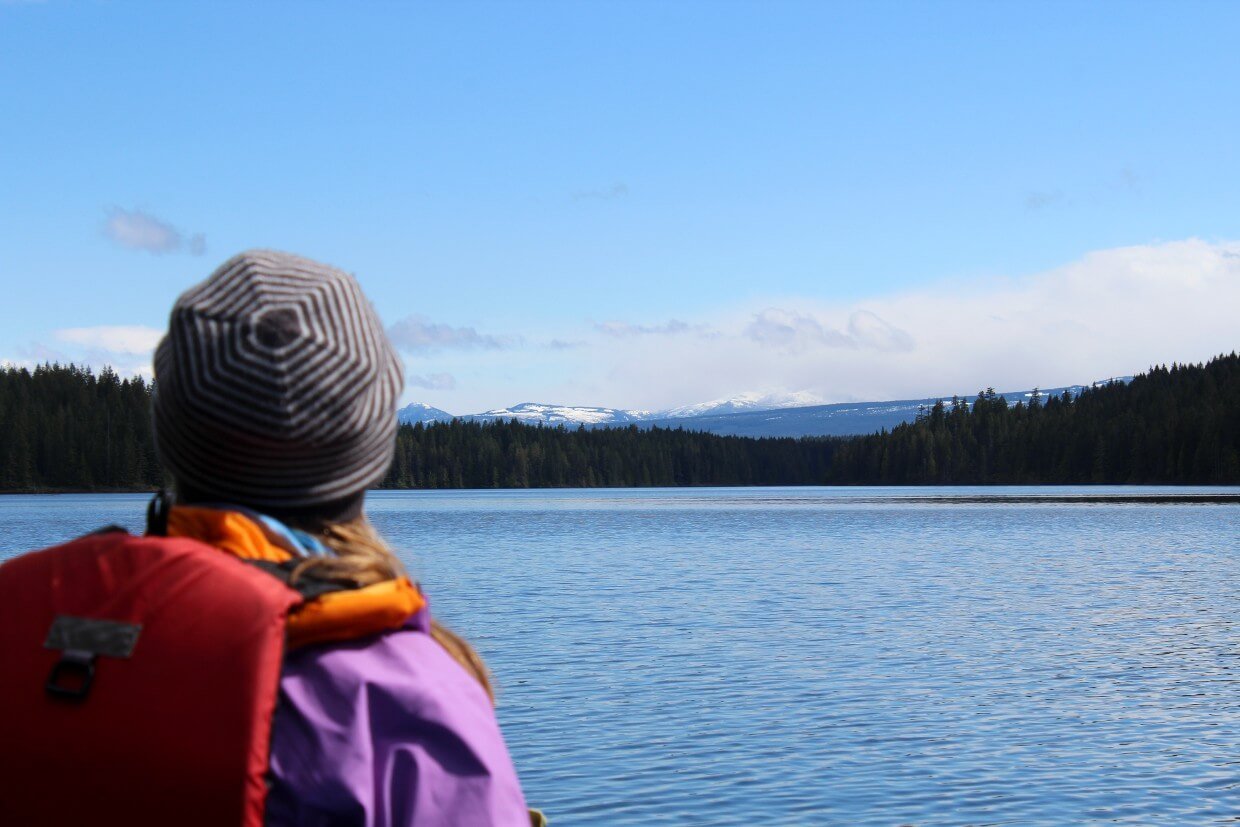
Our experience
Our most recent Sayward Forest Canoe Circuit trip was in mid May 2022. We experienced a mix of rain, wind and sun, with temperatures ranging between 6c to 22c.
We only saw one other couple paddling the circuit (at the end!) and very few boats. Some of the vehicle accessible campgrounds were almost full while others were completely empty.
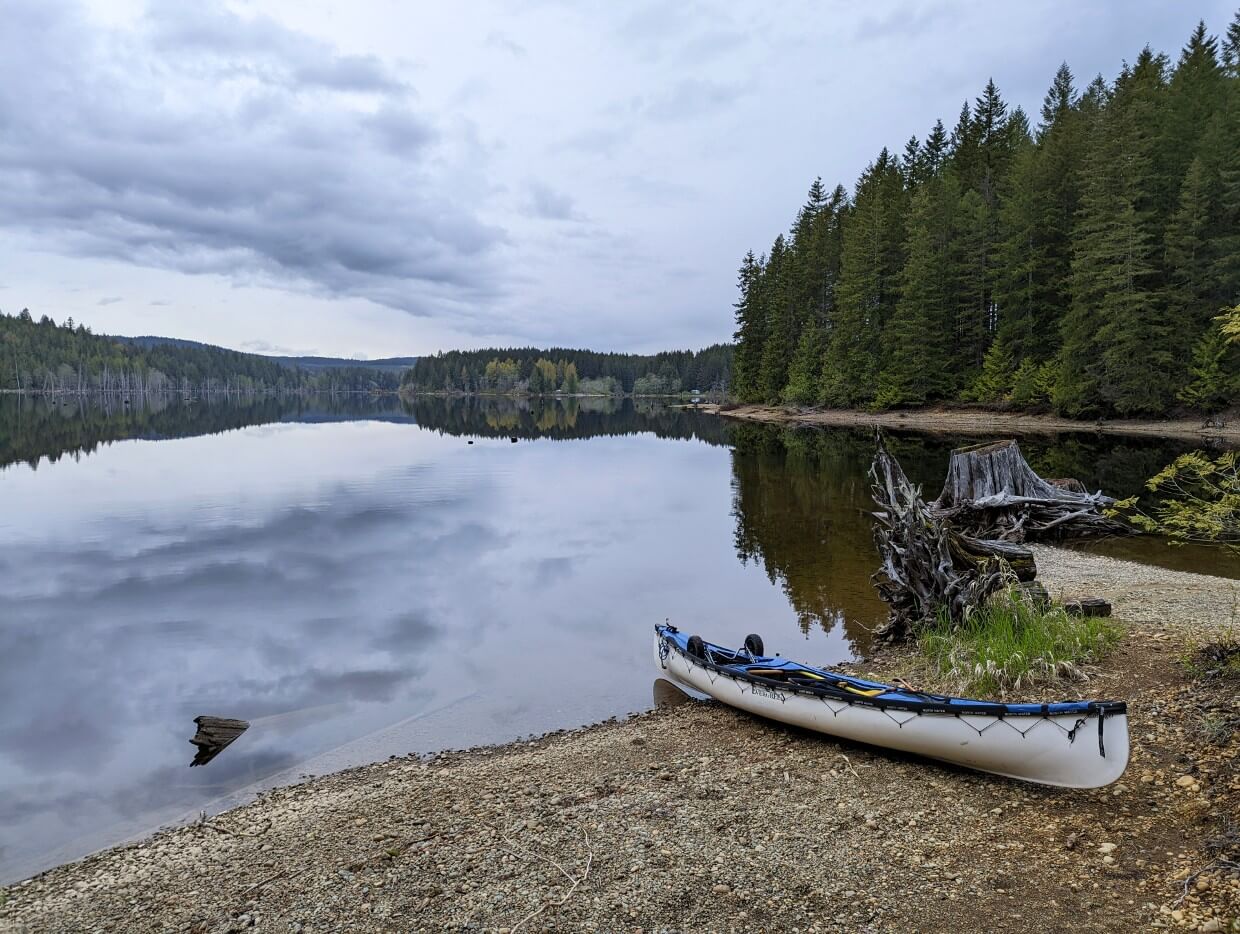
Where to launch
With the Sayward Forest Canoe Circuit being almost entirely circled by logging roads and vehicle-accessible campgrounds, there are many potential launch points.
Mohun Lake is by far the most popular place to start the circuit. I have detailed two common launching points below.
No matter where you launch, remove all items of value from your vehicle.
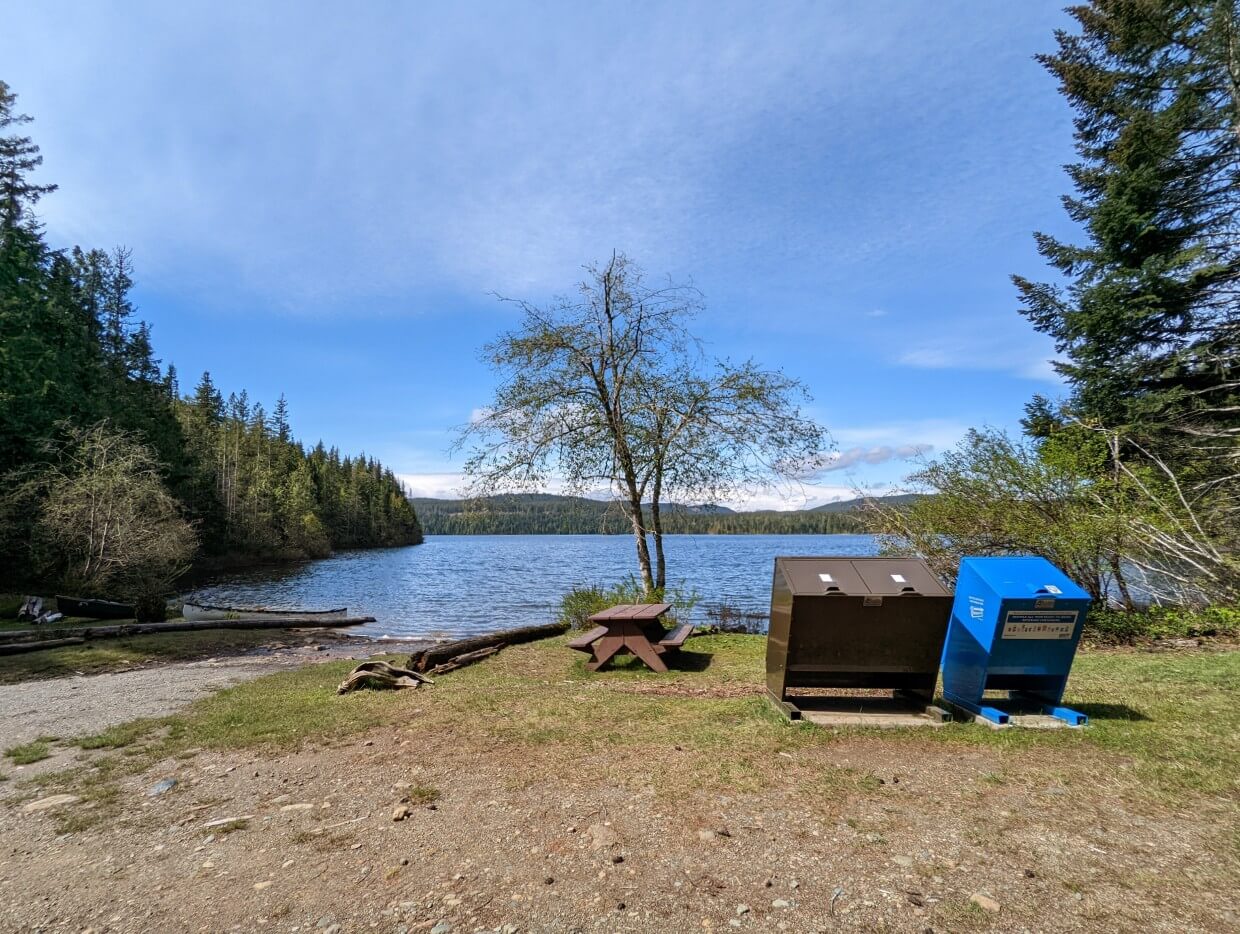
Morton Lake Provincial Park
Morton Lake Provincial Park is located two-thirds of the way up Mohun Lake and features a boat launch with Sayward Forest Canoe Circuit signage.
There is the presence of a Park Facility Operator in the nearby provincial park campground during the main season (April to October).
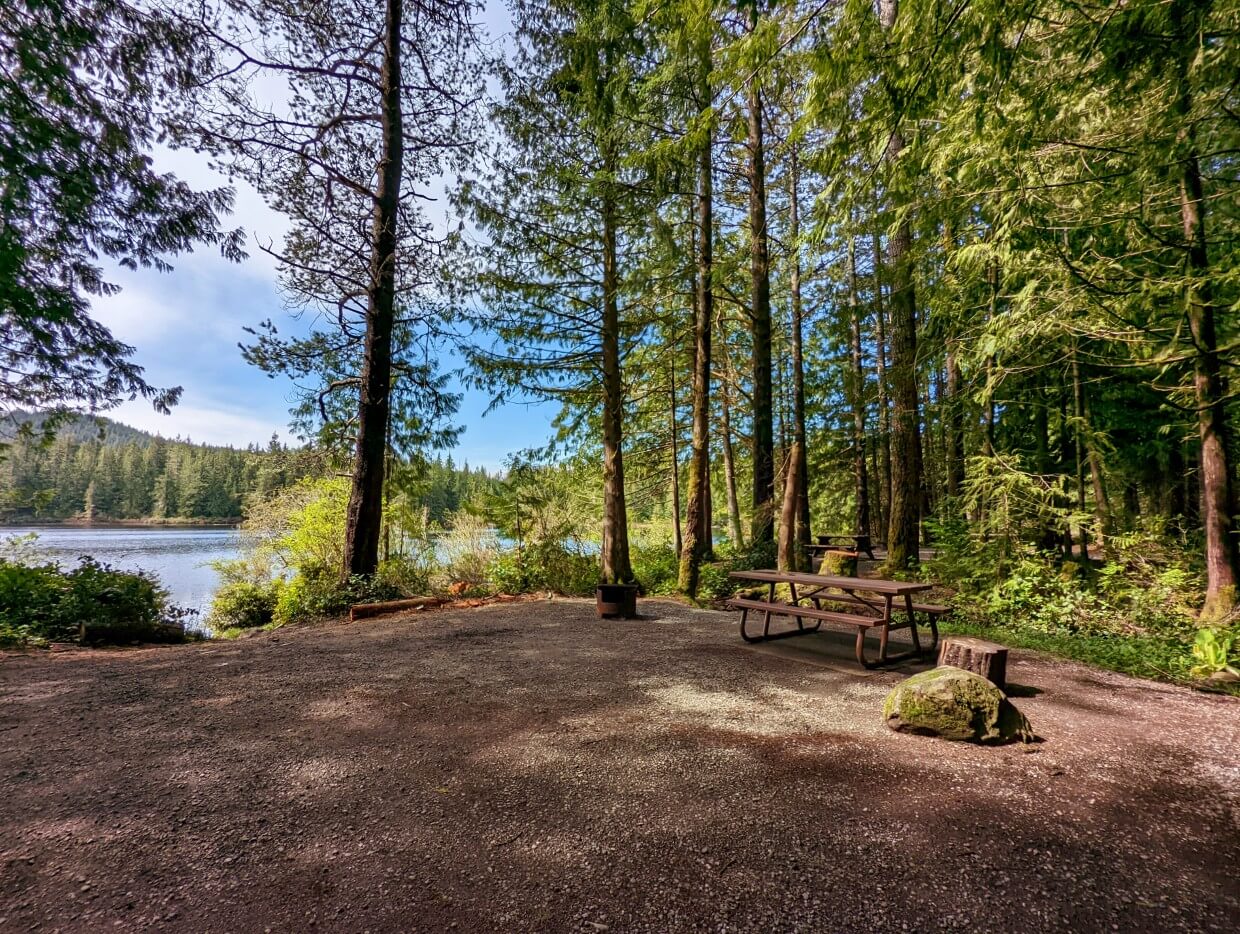
After unloading at the boat launch, paddlers are asked to park vehicles along the park’s access road. If in doubt, ask the Park Facility Operator.
To access Morton Lake Provincial Park, drive north on Highway 19 from Campbell River and then turn left on the Menzies Mainline. This gravel road can often be plagued by potholes.
After 9.6km, there is a turn-off for Morton Lake Provincial Park. The road becomes narrower and climbs above Mohun Lake. The boat launch is 6.5km from the Menzies Mainline.
Please note that Menzies Mainline is an industrial road. Expect to see large logging trucks. Drive with your headlights on and give way to industrial traffic as soon as you can.
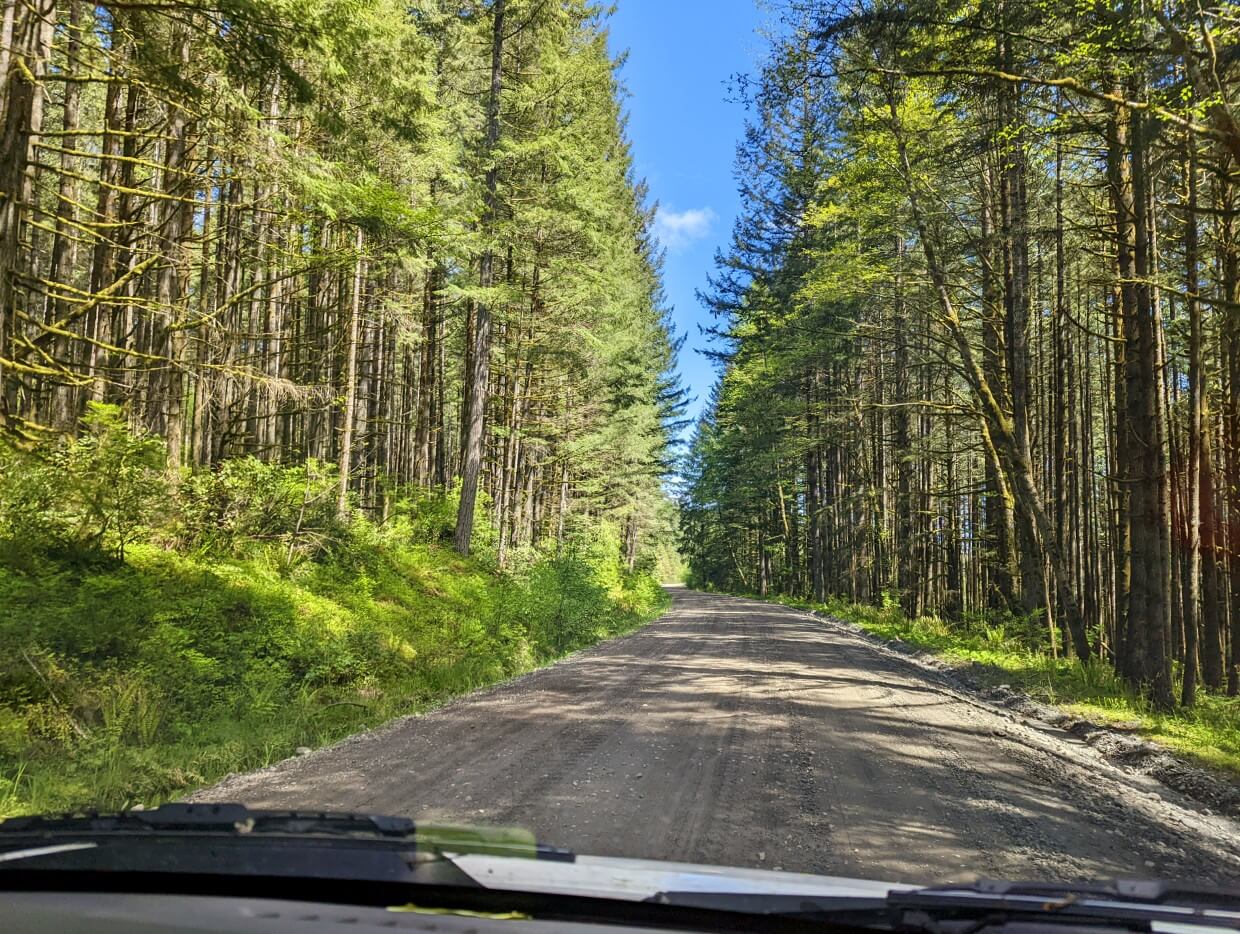
Pacific Yew Recreation Site
The newly built Pacific Yew Recreation Site is situated at the southern end of Mohun Lake. This beautiful 30 site campground is open from mid-May to early September.
There is parking next to the boat launch, designed specifically for Sayward Forest Canoe Circuit paddlers.
To access Morton Lake Provincial Park, drive north on Highway 19 from Campbell River and then turn left on the Menzies Mainline. This gravel road can often be plagued by potholes.
Drive for 10.5km and the entrance to Pacific Yew Recreation Site will be on the right.
Please note that Menzies Mainline is an industrial road. Expect to see large logging trucks. Drive with your headlights on and give way to industrial traffic as soon as you can.
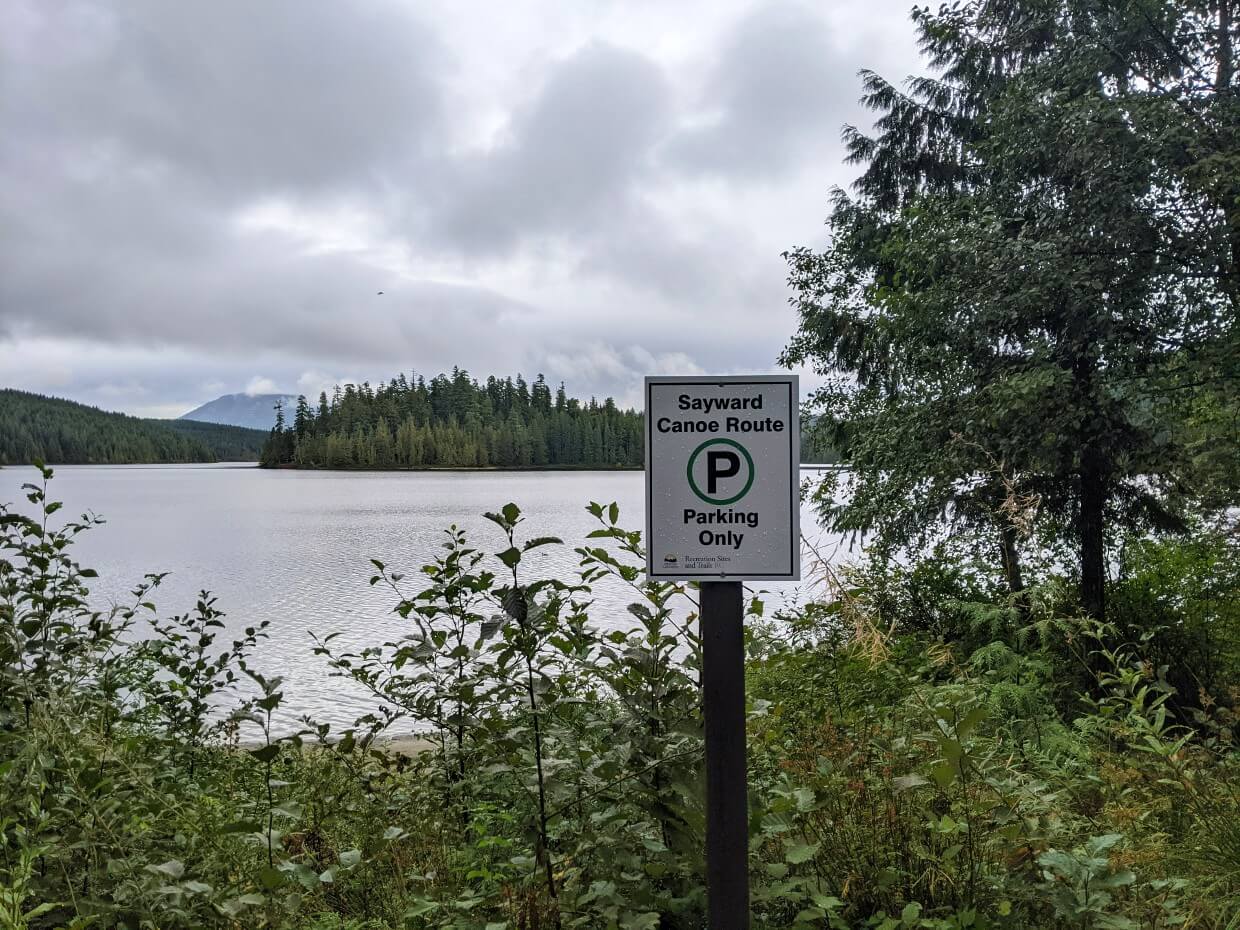
Campgrounds
Camping is permitted almost anywhere on the Sayward Forest but most paddlers use the 30+ established campsites located around the circuit.
The majority of campgrounds completely free to use (identify them with the Sites and Trails website).
Paddlers have a few different types of campsites to choose from:
- Rustic campsites are accessed only by water. Although not formally developed, there are level areas suitable for tents. There may also be wooden benches and tables created by other paddlers. Most have an outhouse in the form of a cedar box or throne
- Developed campsites are also only accessible by water but are more established than the rustic campsites. Mr Canoehead, for example, has picnic tables and metal fire pits. Developed campsites have outhouses in the form of a cedar box or throne
- Vehicle-accessible Recreation Sites are campsites with outhouses, fire pits and picnic tables. There are nine such Rec Sites with a nightly fee on the circuit, each with a caretaker during the main camping season (Brewster Lake, Campbell Lake, Orchard Meadow, Apple Point, Brewster Camp, Gray Lake, Dogwood Bay, Loon Bay, Pacific Yew Recreation Site – all located around the southern side of the circuit)
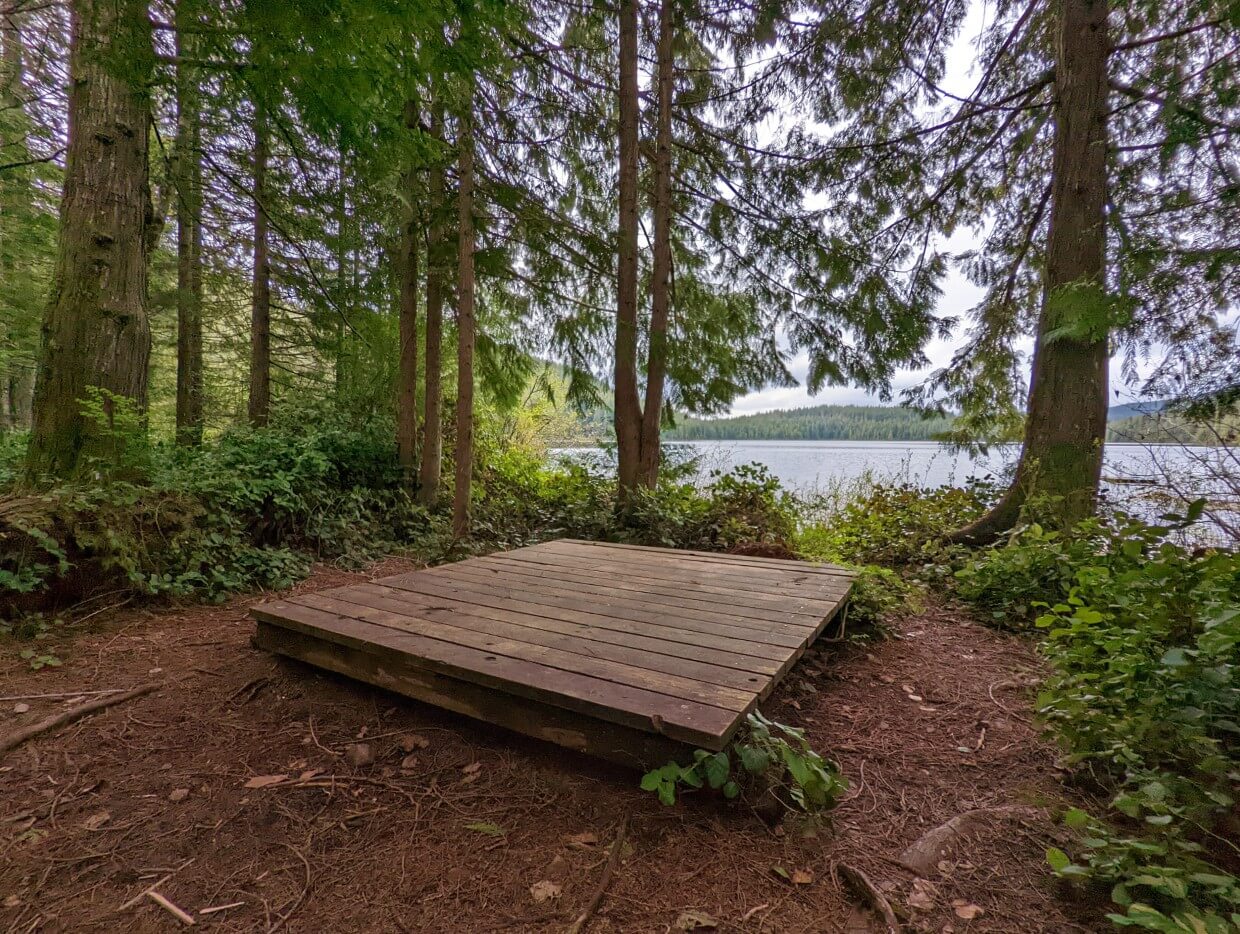
If you’re looking for tranquillity, I’d recommend avoiding the vehicle-accessible Recreation Sites (type 3). These are the most used and can be very busy in the summer months. Due to the presence of RVs, there may be some generator noise as well.
The paddle-in campsites are smaller, lesser used and also better suited to tents. If you have a larger group, you may want to head to the vehicle-accessible Recreation Sites (keep in mine that nine of these have overnight camping fees).
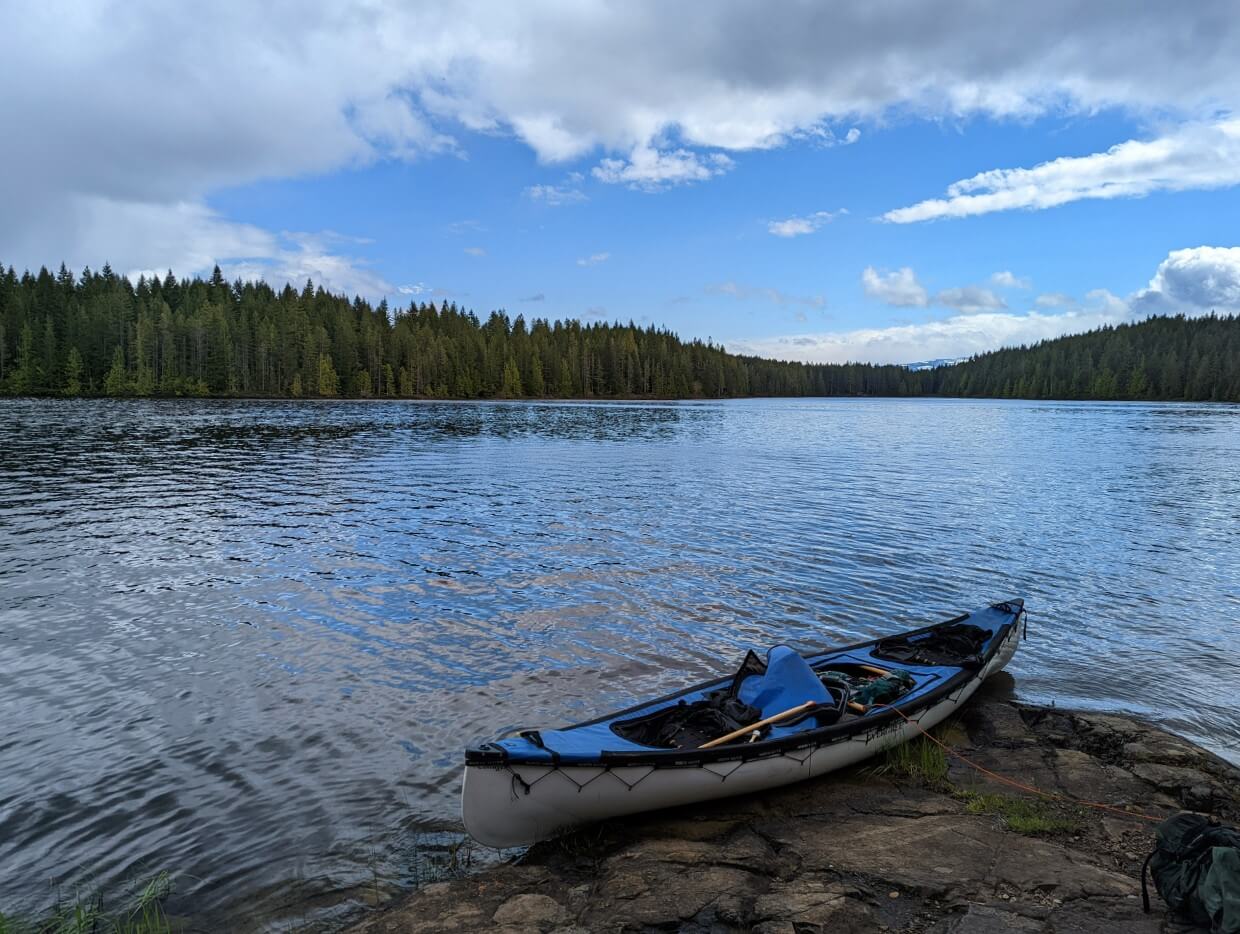
Our favourite campsites on the Sayward Forest Canoe Circuit
- Fry Narrows – This awesome site is located at the very southern end of Fry Lake. Two large tent pads, large picnic table, cedar box toilet, rope swing and metal fire pit. Great views!
- Islands on Amor Lake – There are several beautiful island campsites on Amor Lake. Sterling Island is the largest and features a tent pad, throne toilet and swing. We also like the rustic site on the western side of the lake, near the islands. It has a lovely beach at low water
- Mr Canoehead – This paddle-in Recreation Site features two camping areas, one on Amor Lake and another on Surprise Lake. There are picnic tables and fire pits at both, with three tent pads at the latter. Throne toilet. We’ve never stayed here and always regret it!
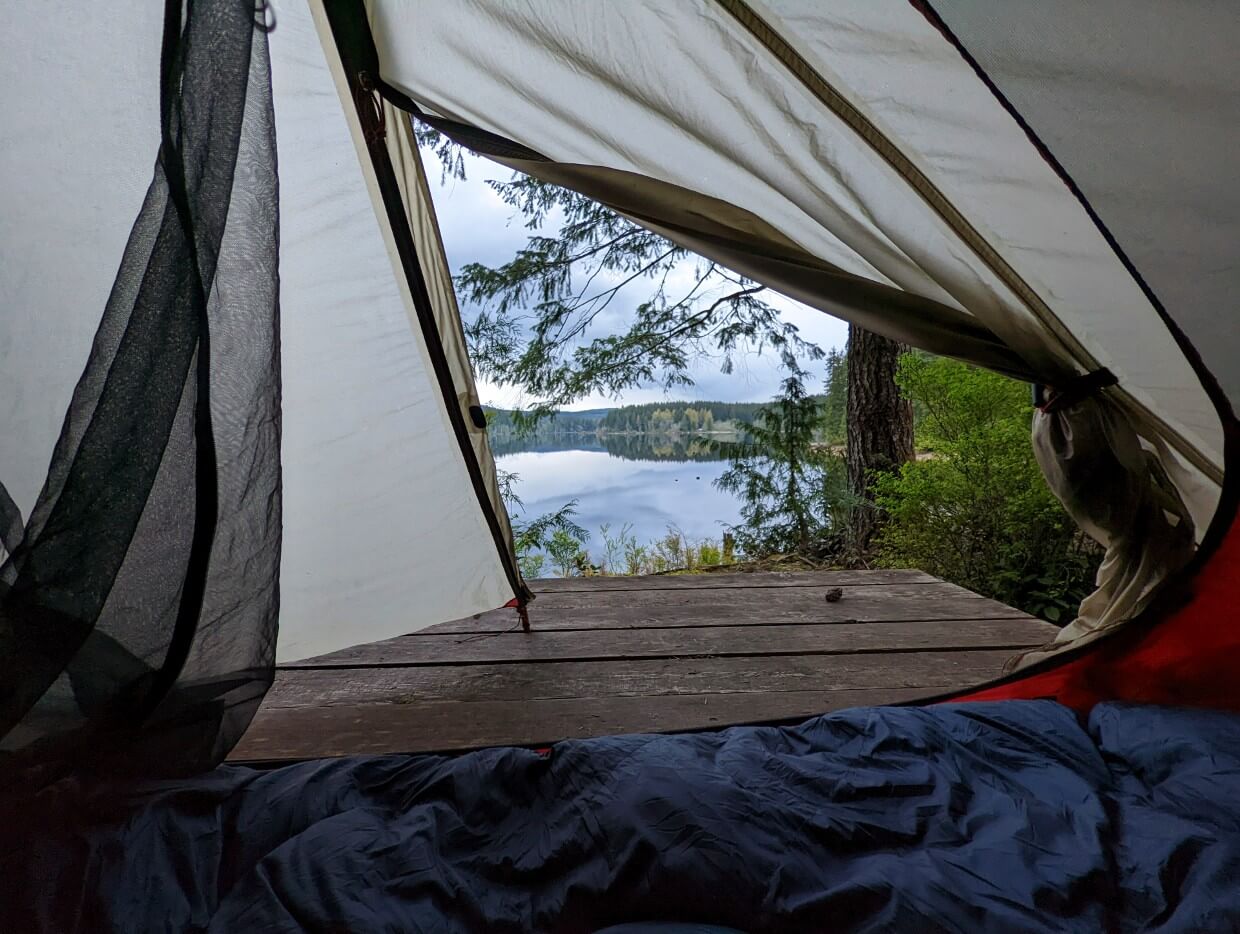
- Beach campsite on Brewster Lake – Situated opposite a grove of old-growth fir trees, this campsite has a large sandy beach. It’s pretty rustic with just a cedar box toilet and no other facilities but the swimming is sure to be excellent in summer. There’s another great paddle-in campsite on the other side of the lake (Brewster Point)
- Mohun Island – This is another paddle-in Recreation Site, located at the southern end of Mohun Lake. There are three tent pads set within a strand of old growth trees, with a spacious fire pit area. There’s a rope swing and cedar box toilet as well
- Island on Goose Lake (Mohun North) – This tiny island campsite sits just beyond the narrows on Mohun Lake. A very pretty spot for a couple of paddlers (one tent only). There is a cedar box toilet
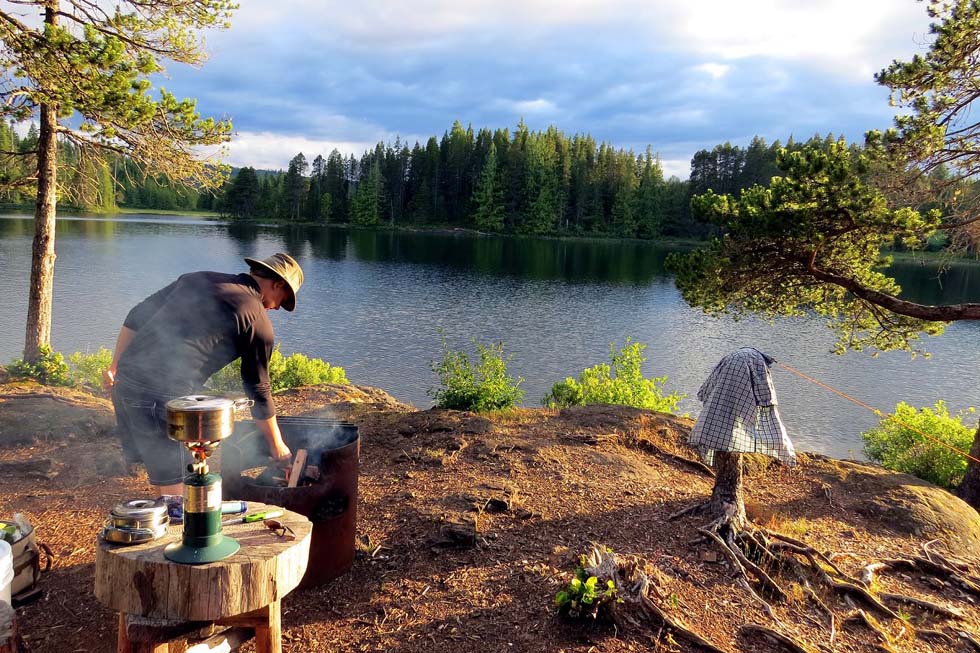
Fees
There are no fees for paddling the Sayward Forest Canoe Circuit. There is no permit or reservation system at this time.
There are 20+ free campgrounds located around the Circuit, all operating on a first-come, first-serve system.
As of 2023, there are nine vehicle-accessible campgrounds that charge overnight camping fees – Brewster Lake, Campbell Lake, Orchard Meadow, Apple Point, Brewster Camp, Gray Lake, Dogwood Bay, Loon Bay and Pacific Yew Recreation Site.
The majority of the campgrounds located around the Circuit are completely free to use and are operated on a first-come, first-serve system.
Other nearby campgrounds, not directly on the circuit, that charge fees are Morton Lake Provincial Park and Loveland Bay Provincial Park.
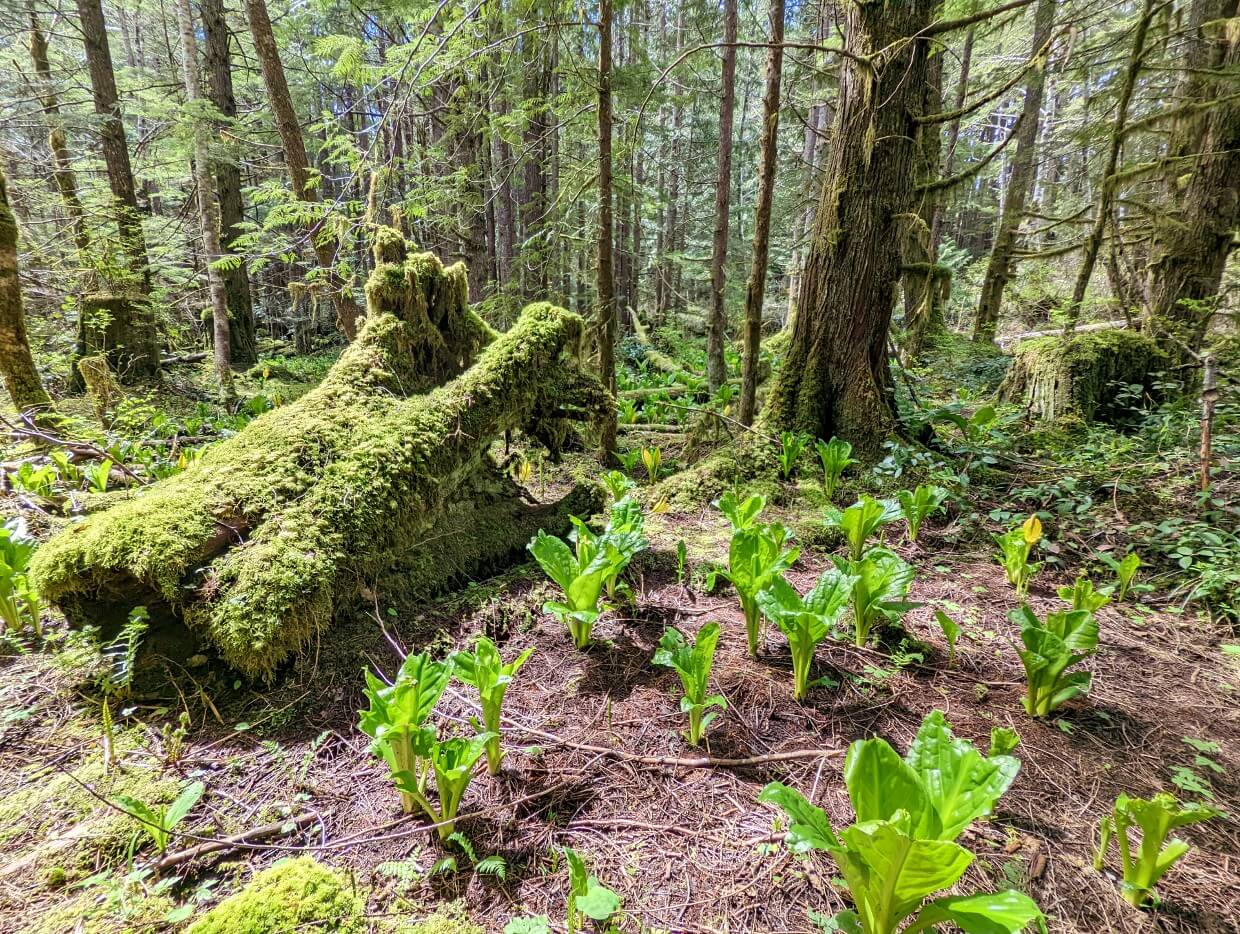
Portages
The Sayward Canoe Circuit features 12 portages. If unfamiliar, a portage is a trail between two water bodies (lakes, rivers, ponds etc.)
The portages on the Sayward Canoe Circuit range from 0.1km to 2.3km and are well marked, with signage indicating the start from both directions. Most of the portages have distance markers as well.
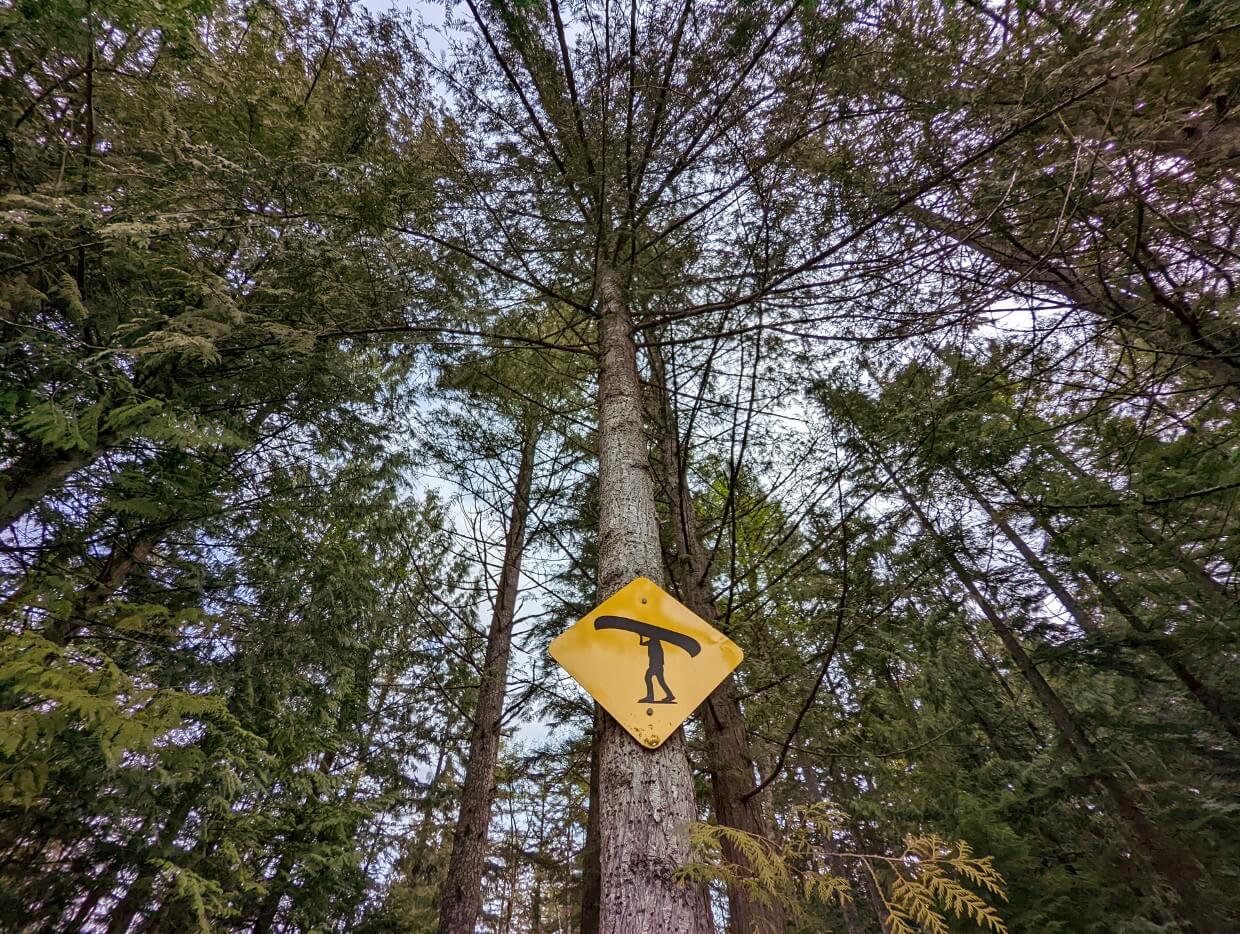
A canoe cart can be used on the majority of the portages. An expedition cart would be preferable as some of the portage paths feature exposed roots and rocks (see notes below). We used a kayak cart on our recent trip and had to lift our canoe up over larger obstacles.
Paddlers planning to traditionally carry their canoe (over the head), will be happy to hear that there are regular canoe rests on every portage longer than 200m.
I’m not sure how often the portages are maintained but expect to see some downed trees and foliage on the trails in spring and also after wind storms.
Paddling the circuit in mid-May, we found that most of the portages had been recently bushwhacked.
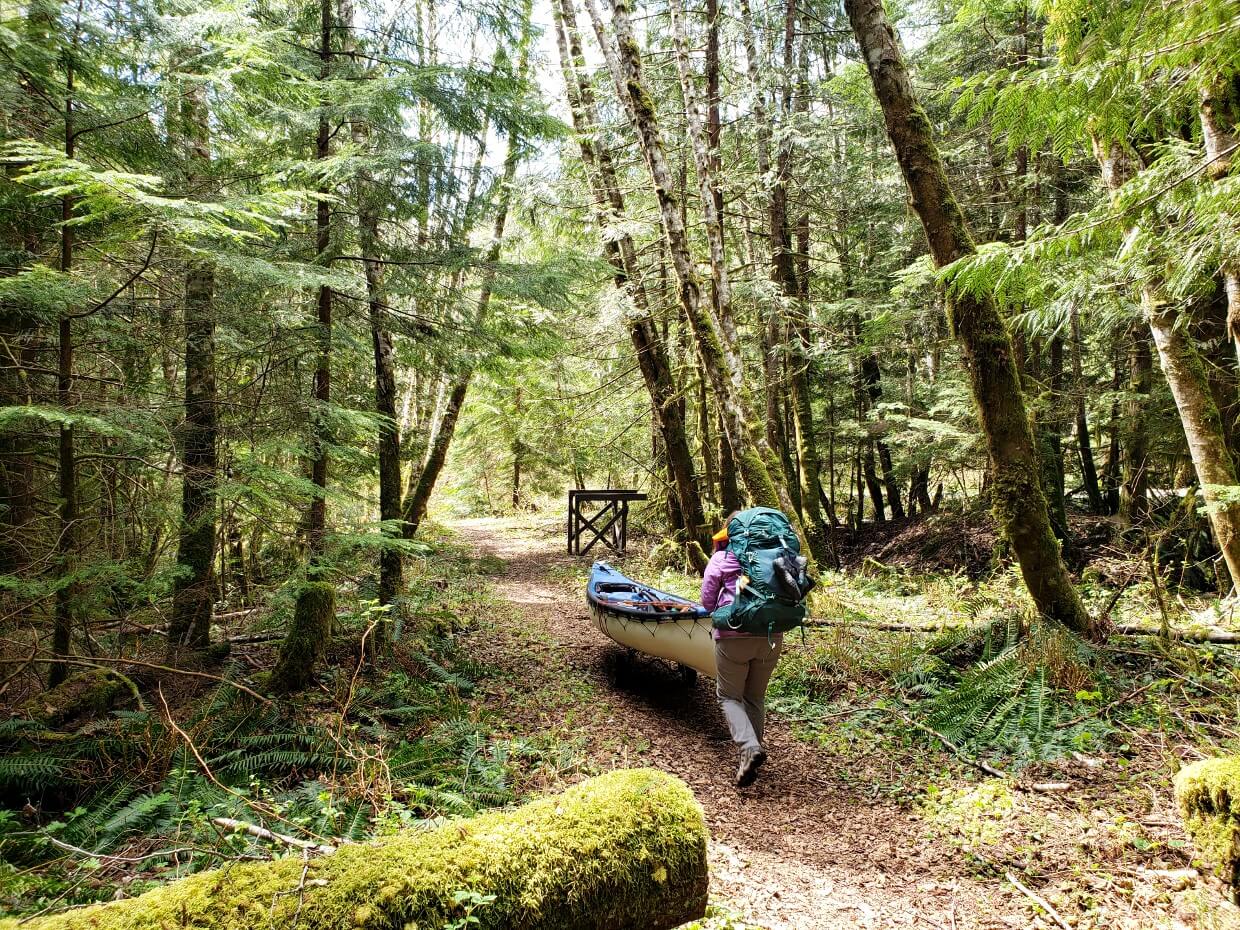
Portage descriptions
- Goose Lake/Mohun North to First Pond, 1.6km – Multiple short climbs and descents, rocky and rooty throughout. We found some downed trees in spring
- First Pond to Second Pond, 35m – Easy flat carry between ponds. At low water levels, this portage is 100m longer
- Twin Lakes to Amor Lake, 800m – Mostly downhill, some very rocky and rooty sections
- Amor Lake to Surprise Lake, 100m – Easy flat path through forest, cleared of most roots and rocks
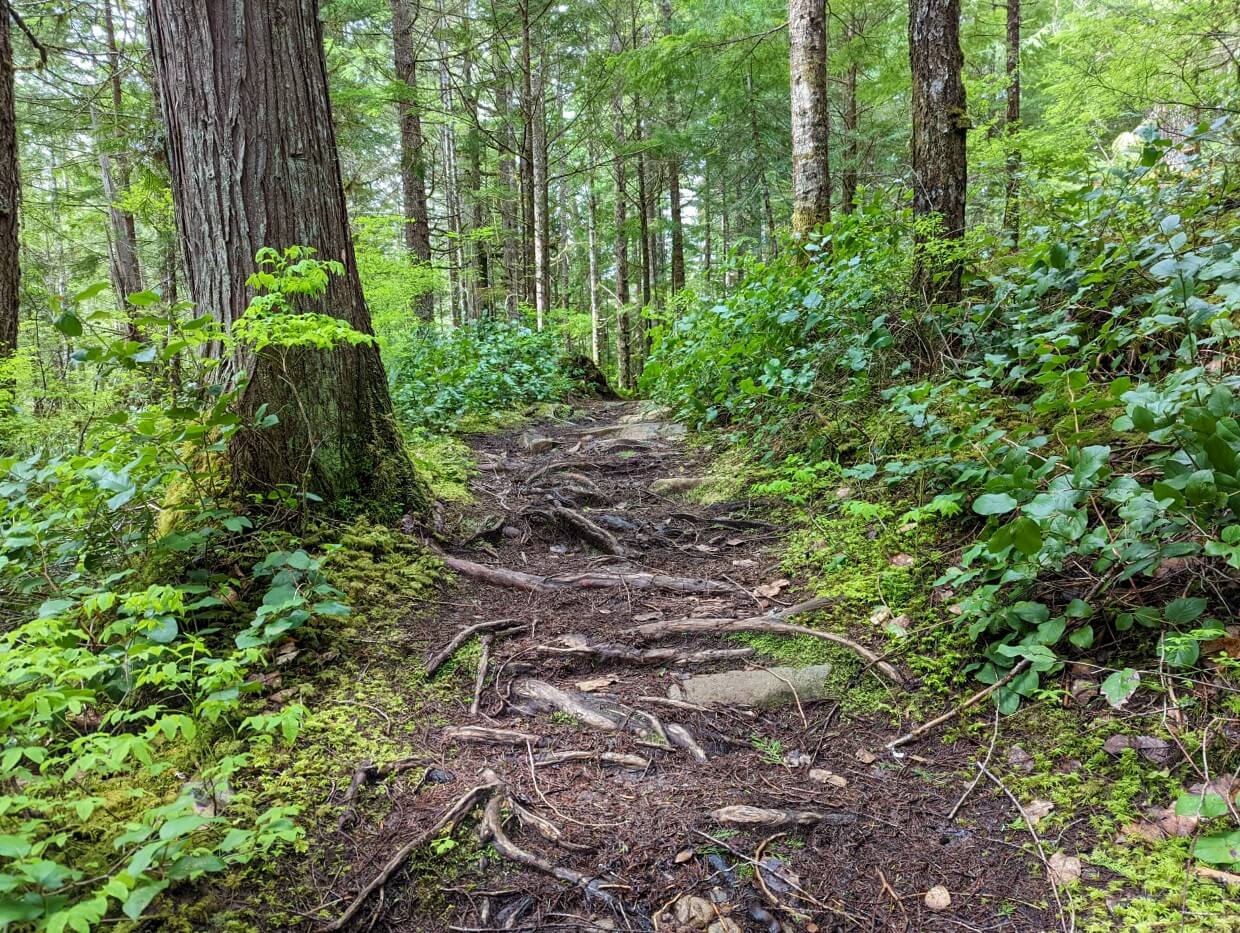
- Surprise Lake to Brewster Lake, 2.3km – Starts with a steep hill then flattens out. The wide level path parallels a logging road and is mostly cleared of roots and rocks
- Brewster Lake to Whymper Creek, 100m – Easy, mostly flat path cleared of rocks and roots. Mostly cleared of roots and rock. Some downed trees in spring
- Gray Lake to Whymper Creek, 300m – Easy path with one hill. Couple of downed trees in spring
- Whymper Lake to Fry Lake, 400m – Easy path with a few very small hills. Mostly cleared of roots and rock

- Campbell Lake to Gosling Lake, 1.1km – Almost entirely on logging road, with a steady climb from Gosling Bay and then a steeper climb after crossing Lower Campbell Lake Road. The final section is a wide, flat path
- Gosling Lake to Higgins Lake, 200m – Landing is very muddy. The first section features a wide flat path, second section is a logging road
- Higgins Lake to Lawier Lake, 300m – Steep but short climb from landing point, exposed rock sections then rooty forest path. Would not recommend using a canoe cart
- Lawier Lake to Mohun Lake, 300m – Easy portage, almost entirely on a logging road. Downhill section into Mohun Lake Recreation Site
Additional 100m portage may be required close to the end of Gray Lake, where a logjam can form around the old railway trestle. In spring 2022, we were able to move the logs around and continue paddling.
During low water periods, paddlers will need to line their canoes along some sections of Whymper Creek (300m then 400m).
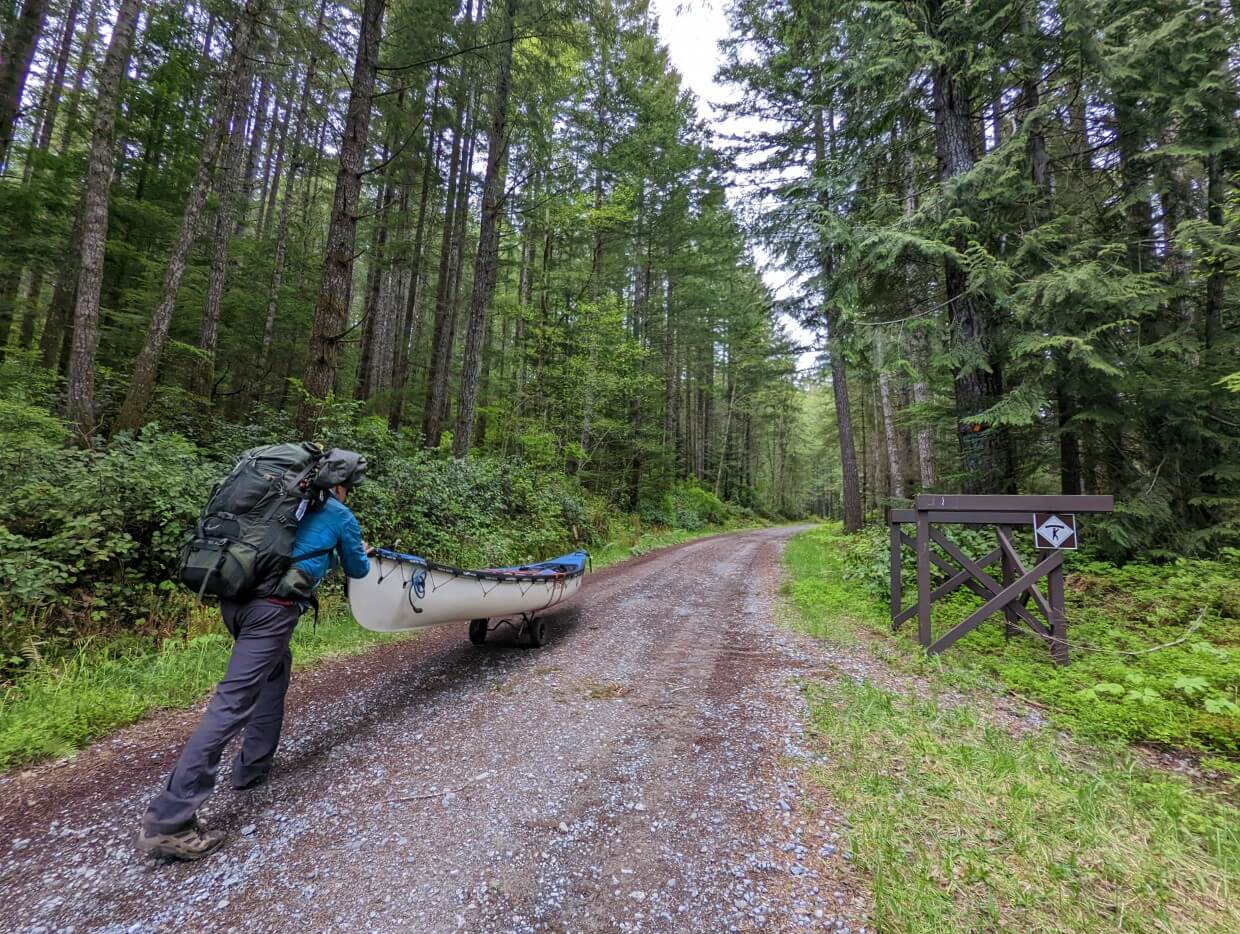
Portage tips
- If using a canoe cart, the portages are relatively straightforward. Be prepared to lift your canoe over some of the larger rocks and roots and potentially some fallen trees
- The longest portage (2.3km from Amor to Brewster) is a lot easier than others on the Sayward Circuit. It is very flat after the first hill
- It is a good idea to practice portaging at home if planning to overhead carry
- If carrying the canoe overhead, keep in mind that it takes more organisation at the start and end of each portage, which makes progress slower
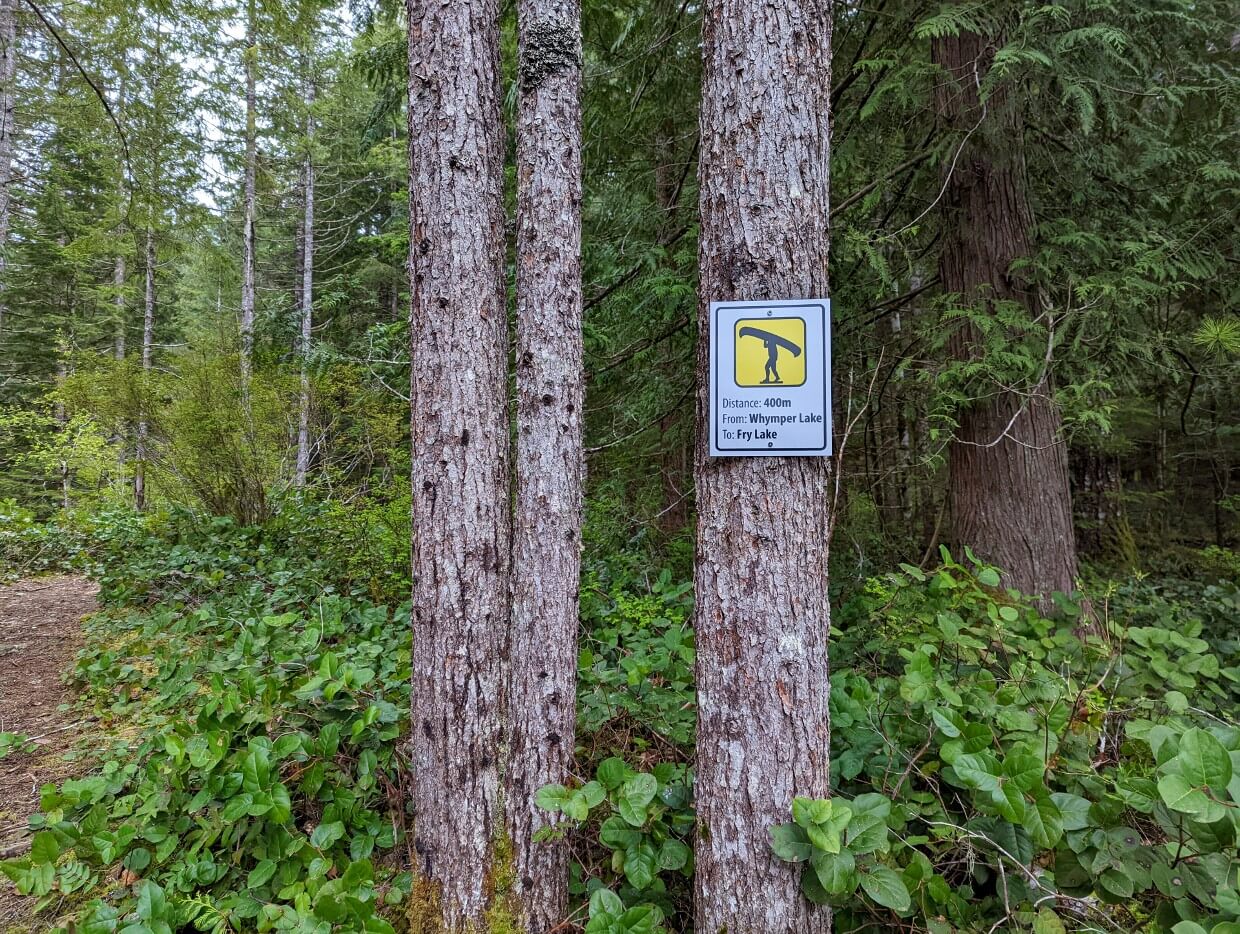
- Paddlers portaging the old fashioned way will likely find the Campbell Lake to Gosling Lake portage to be the most difficult. There are, however, four canoe rests along the way
- One comment from Jean Robert about portaging with the canoe on his head on our first Circuit trip was that he didn’t get to see much of the trails
- Some of the put-ins and take-outs can be muddy, dependent on the season and weather. Be sure to wear suitable shoes for portaging and for getting in and out of the canoe
- Don’t underestimate how long it takes to portage. Though the distance on the map may seem short, portaging is more than just walking the trail. You have to unpack the canoe, organise your gear, transport it and the canoe along the trail and then repack at the other end. Depending on the amount of gear you have, you may need to portage twice
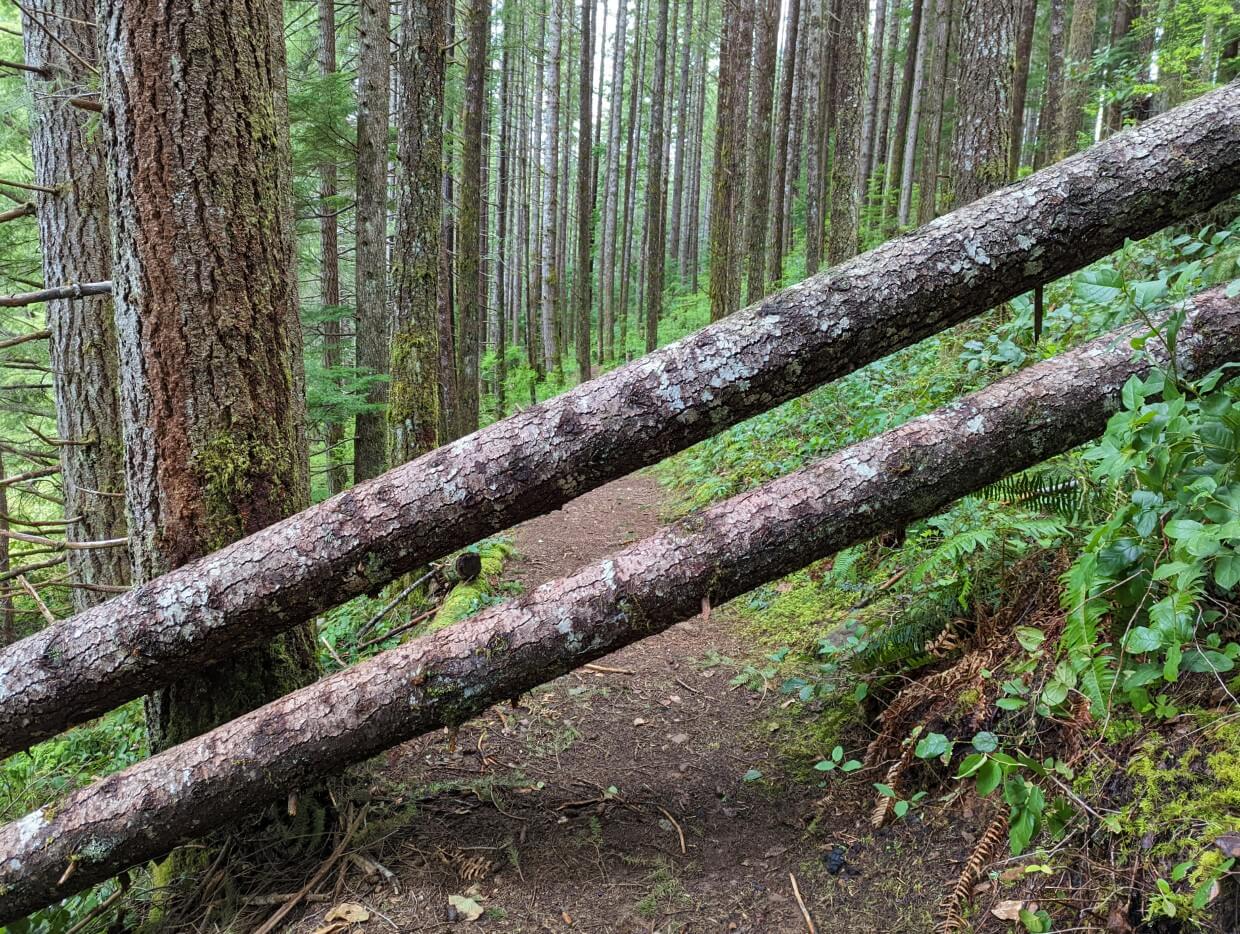
Itinerary suggestions
With more than 20 campgrounds located around the circuit and numerous places to launch, there are so many ways to structure your adventure on the Sayward Forest Canoe Circuit.
It is recommended to travel in a counter clockwise direction due to the river sections (indeed, they would prove to be quite a challenge in the other direction!)
Most paddlers explore the circuit for four to five days, though the choice is completely yours.
It is possible to complete the Circuit in two days, with camping just one night. However, this trip plan requires two very long days of paddling (think 9am to 7pm) and good weather.
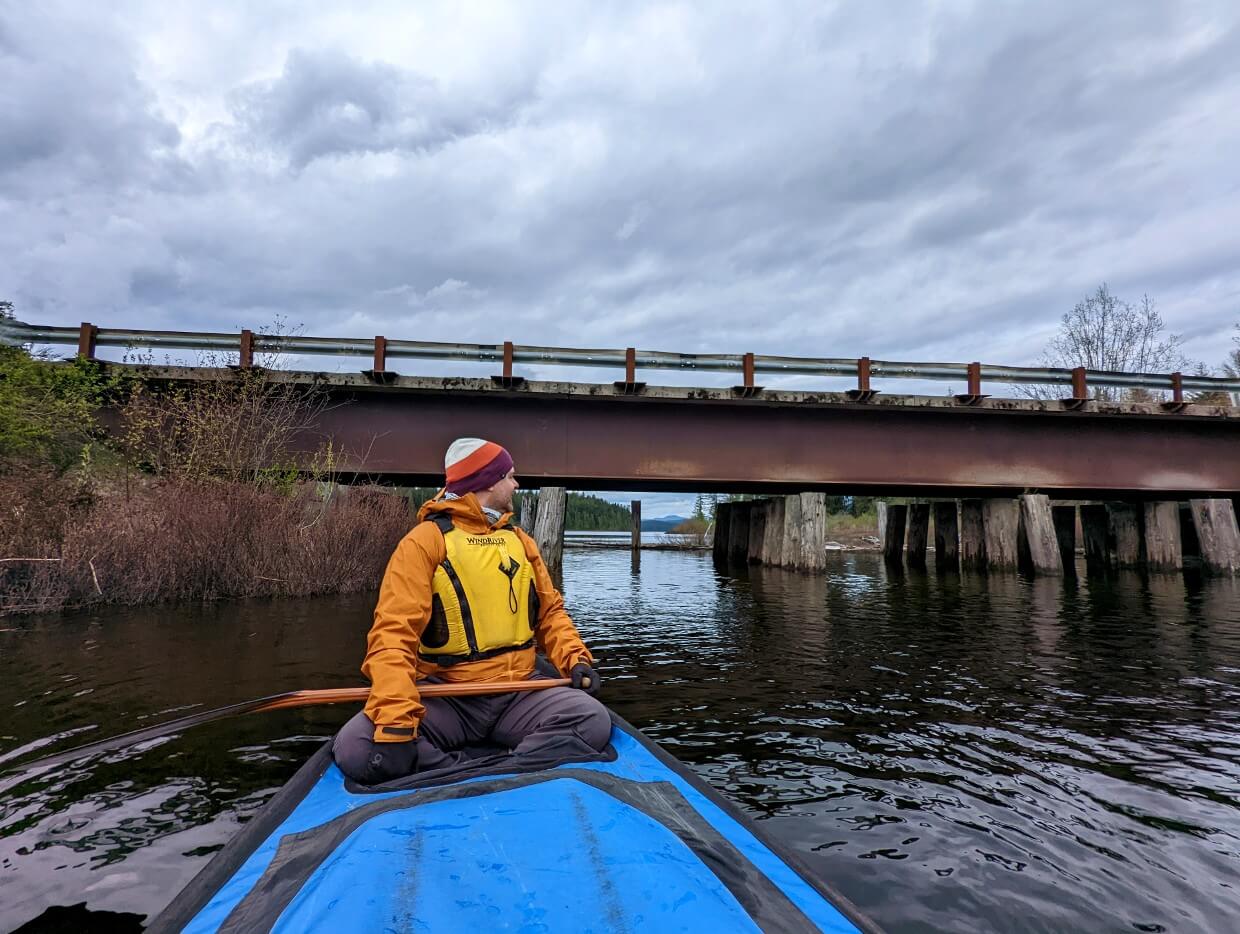
Five days is the perfect length of time for a trip (in my opinion) as it allows for one bad weather/lazy day as well as shorter paddling/portaging days overall.
Depending on the conditions, you may prefer to keep a very loose schedule and just see where the day takes you.
Whatever you do, be sure to slow down. The Sayward Canoe Circuit features many small lakes. Be conscious not to hurry.
Whymper Lake was one of my favourite lakes and it is the smallest on the circuit. It was such a lovely quiet little lake, covered in lily pads and not accessible by any road.
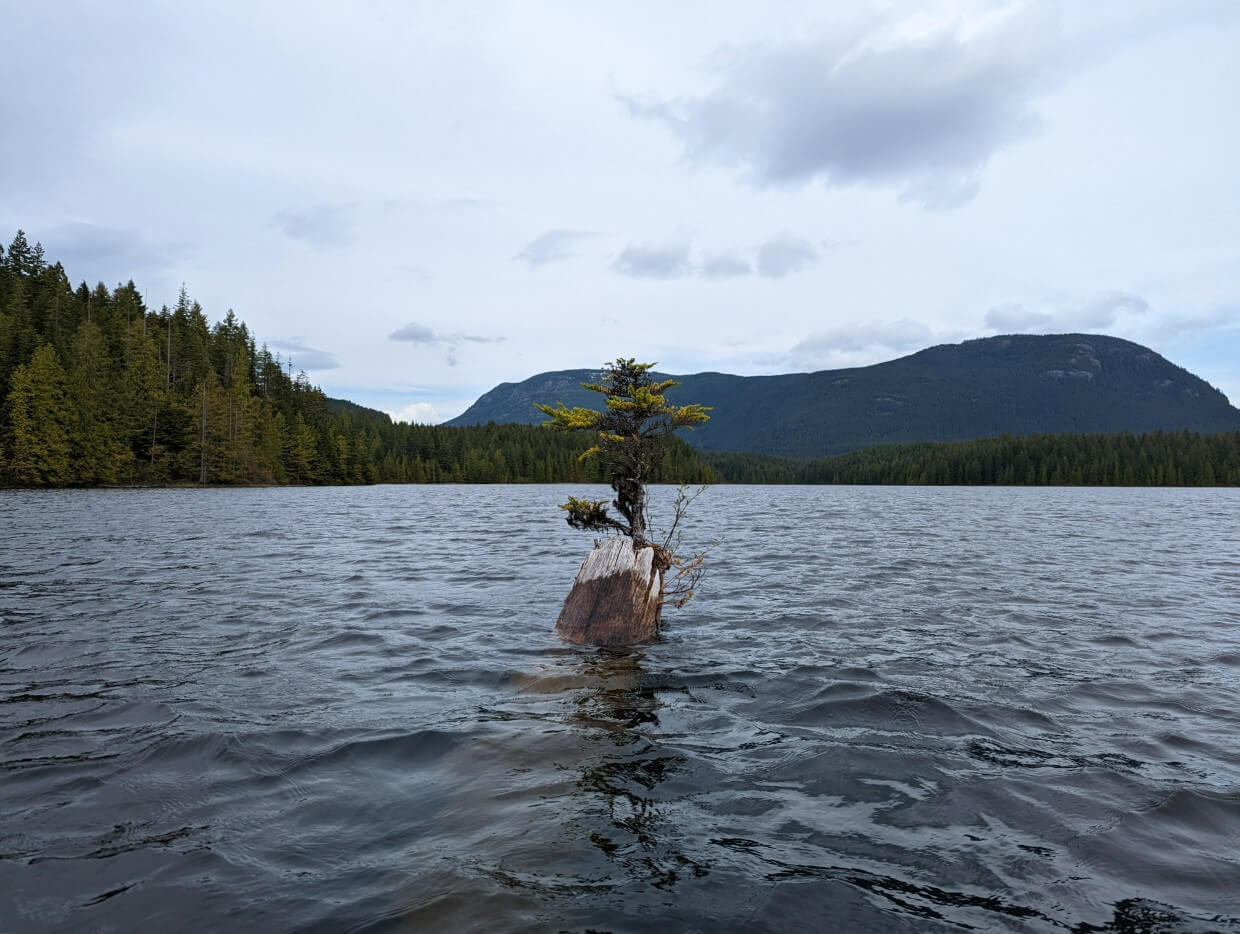
Five day, four night itinerary
- Day 1: Launch on Mohun Lake, overnight on Amor Lake
- Day 2: Overnight on Brewster Lake
- Day 3: Overnight on Fry Lake
- Day 4: Overnight on Mohun Lake
- Day 5: Paddle back to put-in on Mohun Lake
This Sayward Forest Canoe Circuit itinerary is one of the most popular, especially in the warmer months.
It nicely divides the portages and paddling, offering some downtime on Brewster Lake after the longest portages are finished. This trip plan also features the best campsites, at least in my opinion!
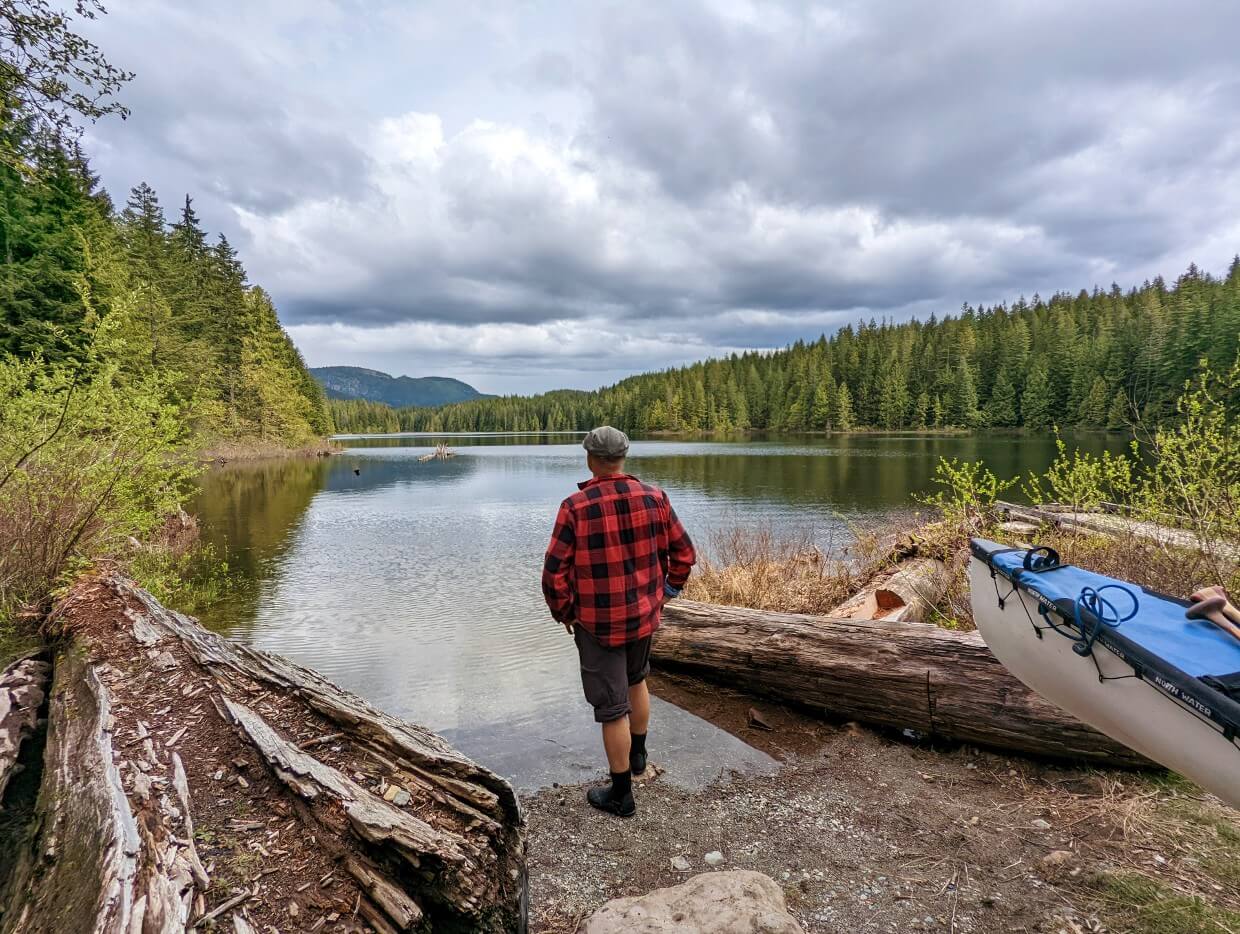
Four day, three night itinerary
- Day 1: Launch on Mohun Lake, overnight on Amor Lake
- Day 2: Overnight on Fry Lake
- Day 3: Overnight on Mohun Lake
- Day 4: Paddle back to put-in on Mohun Lake
Our recent shoulder season trip followed this shorter itinerary. With the weather being on the cool side, stopping at Brewster Lake wasn’t as appealing as it would be in the summer.
The overnight stay at Fry Lake is very convenient for the potentially windy paddle across Campbell Lake. Note, however, that Day 2 is quite long, depending on weather conditions.
On our previous circuit trip, we followed the following itinerary:
- Day 1: Launch on Brewster Lake (early evening), overnight on Gray Lake
- Day 2: Overnight on Goose Lake (Mohun North)
- Day 3: Overnight on Amor Lake
- Day 4: Paddle back to put-in on Brewster Lake
This trip plan featured one very long day (from Gray Lake to Goose Lake) and that reason, I wouldn’t recommend it. Staying at Fry Lake on Day 1 would be preferable.
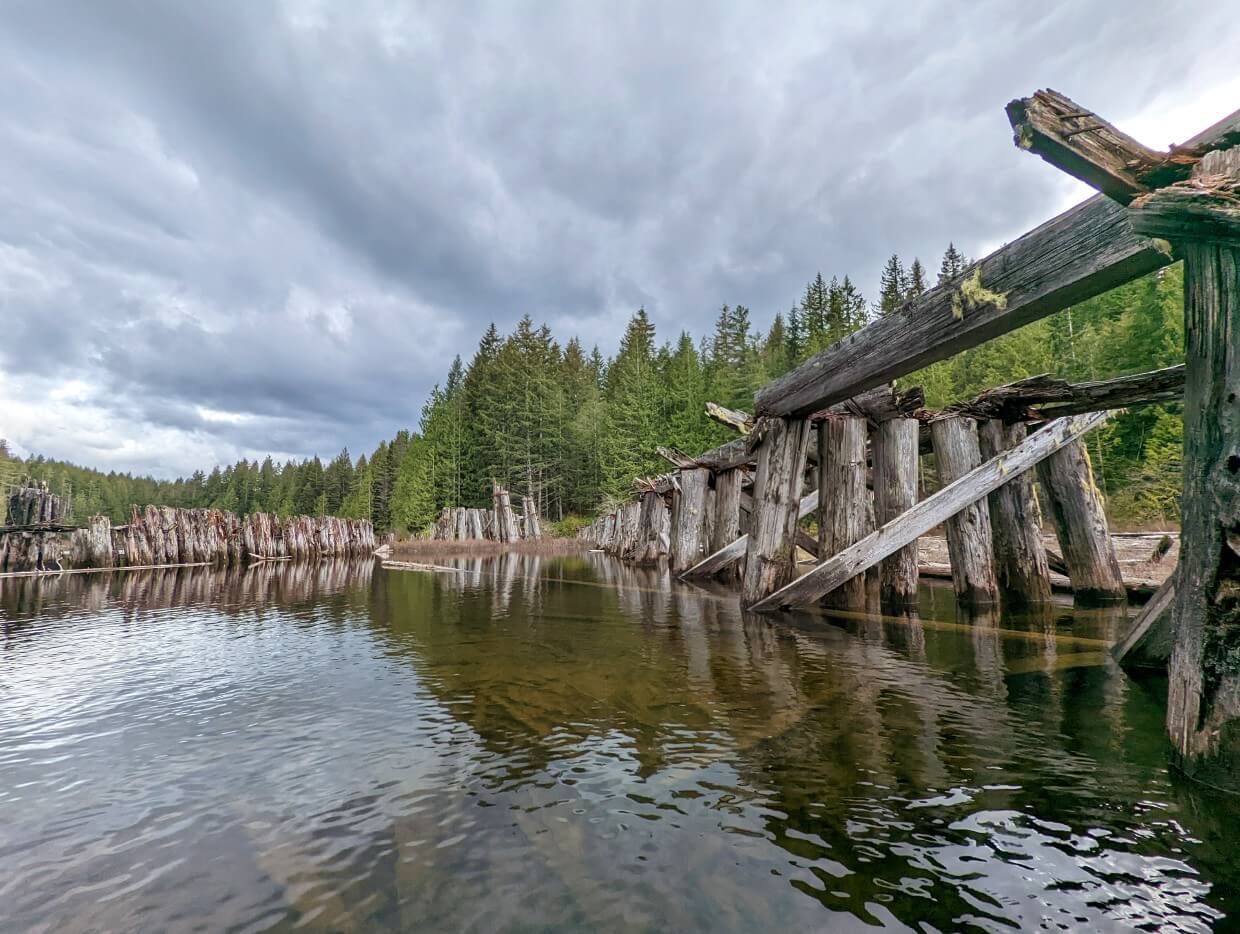
Canoe rentals
Comox Valley Kayaks rents canoes and canoe carts. The canoes are suitable for 2+ people.
If you don’t have a roof rack, they will provide and install one for you (for free!) Alternatively, it may be possible to arrange delivery and pick-up.
Comox Valley Kayaks is located in Courtenay, about 65km south of the Sayward Forest Canoe Circuit. I am not aware of any canoe rentals in Campbell River.
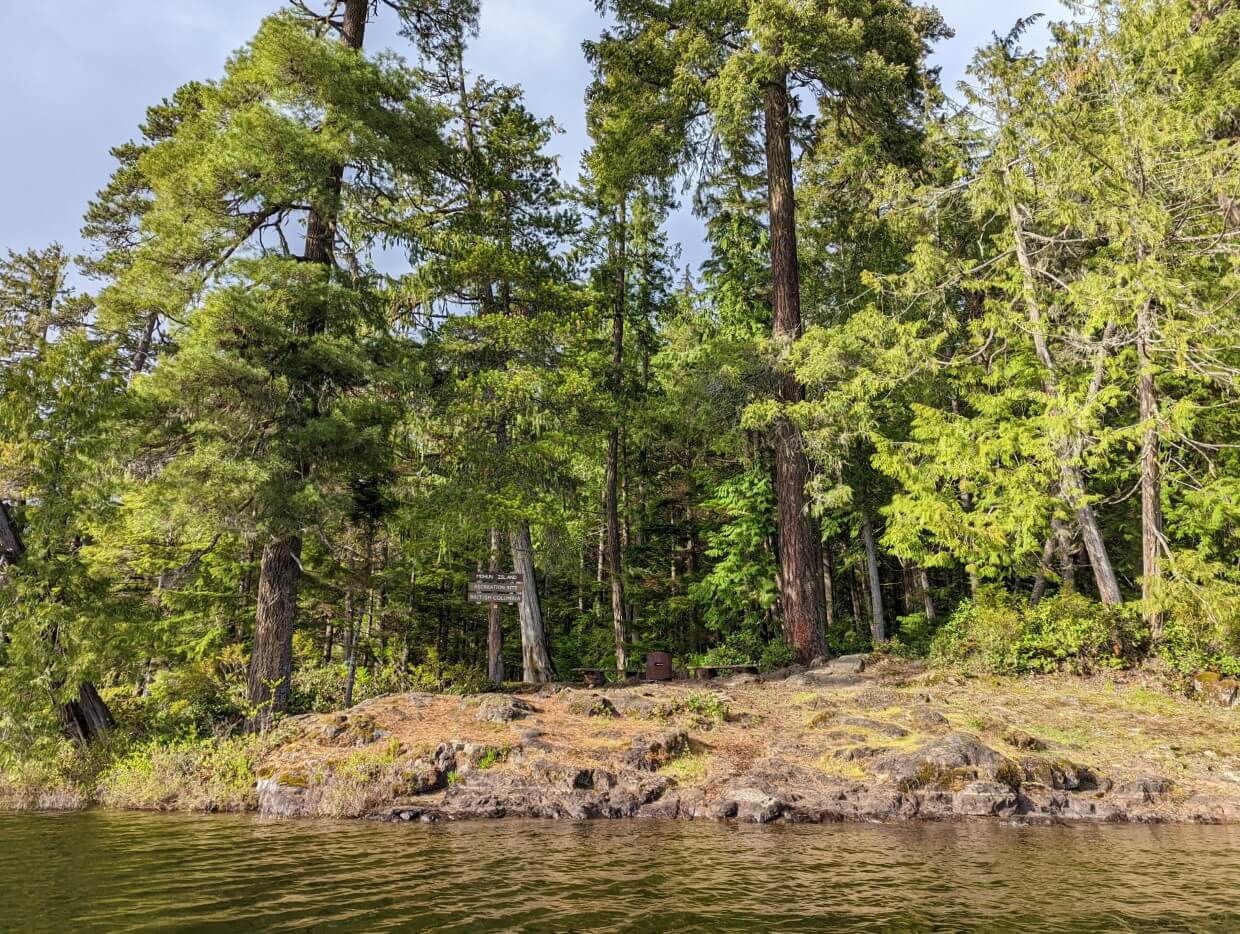
Wildlife
The Sayward Forest is home to a variety of animals, including black bear, elk, deer, beavers, otter, osprey, bald eagle, owl, loon, cougar and wolf. The latter are seen very rarely.
Paddlers have the benefit of being able to move quietly, something that can result in more wildlife sightings.
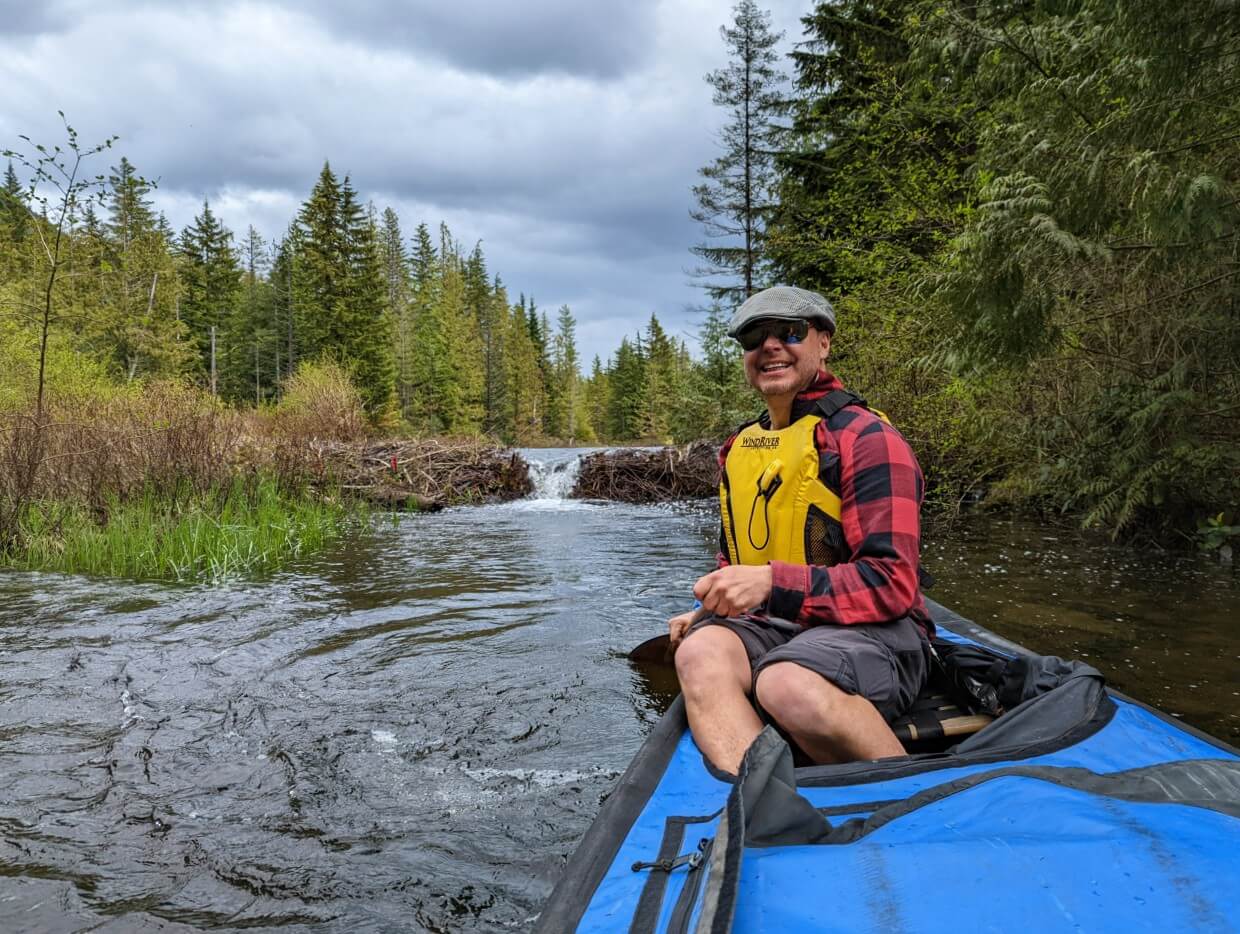
If you do see any wildlife, remember to keep a respectful distance. This allows the animal room to escape. Be careful to clean up properly after eating to ensure that you do not accidently feed any animals.
None of the Sayward Forest campsites have bear caches. Paddlers should be prepared to hang food and other attractants out of reach of animals.
Fishing is a very popular activity in the Sayward Forest, with rainbow trout, kokanee and Dolly Varden most commonly caught. If you fish, fillet away from camp and then dispose of the remains in deep water.

Safety information
While the Sayward Forest is well travelled by recreationalists (and loggers), this canoe circuit is still located in a backcountry wilderness area.
It is possible that you may not see anyone during your trip. There is also no phone signal after turning off Highway 19. Should you need emergency help, it will take some time to arrive.
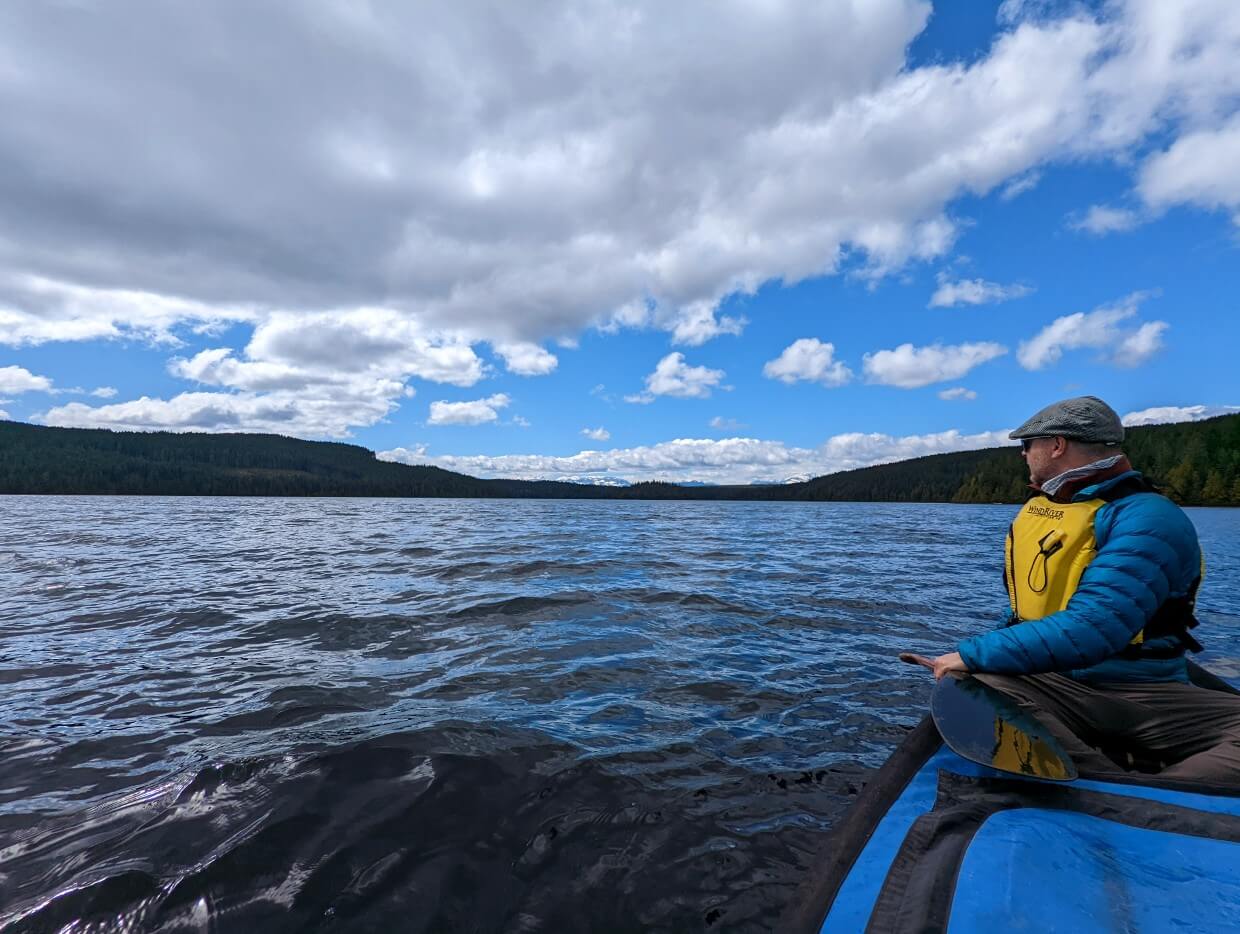
For this reason, paddlers must be self sufficient.
- Bring the 10 Essentials to ensure that small inconveniences do not progress to emergency situations
- Check the weather forecast before leaving and carry the appropriate equipment and clothing
- Leave a trip plan with a trusted friend or family member and check in with them once you have safely returned
- Consider bringing a satellite device so you can call for help or communicate with friends and family
- Know and stay within your limits. If the conditions are too rough to paddle safely, get off the lake and wait it out
- Wear a PFD at all times (with a whistle) and carry a throw rope and bailing bucket/pump
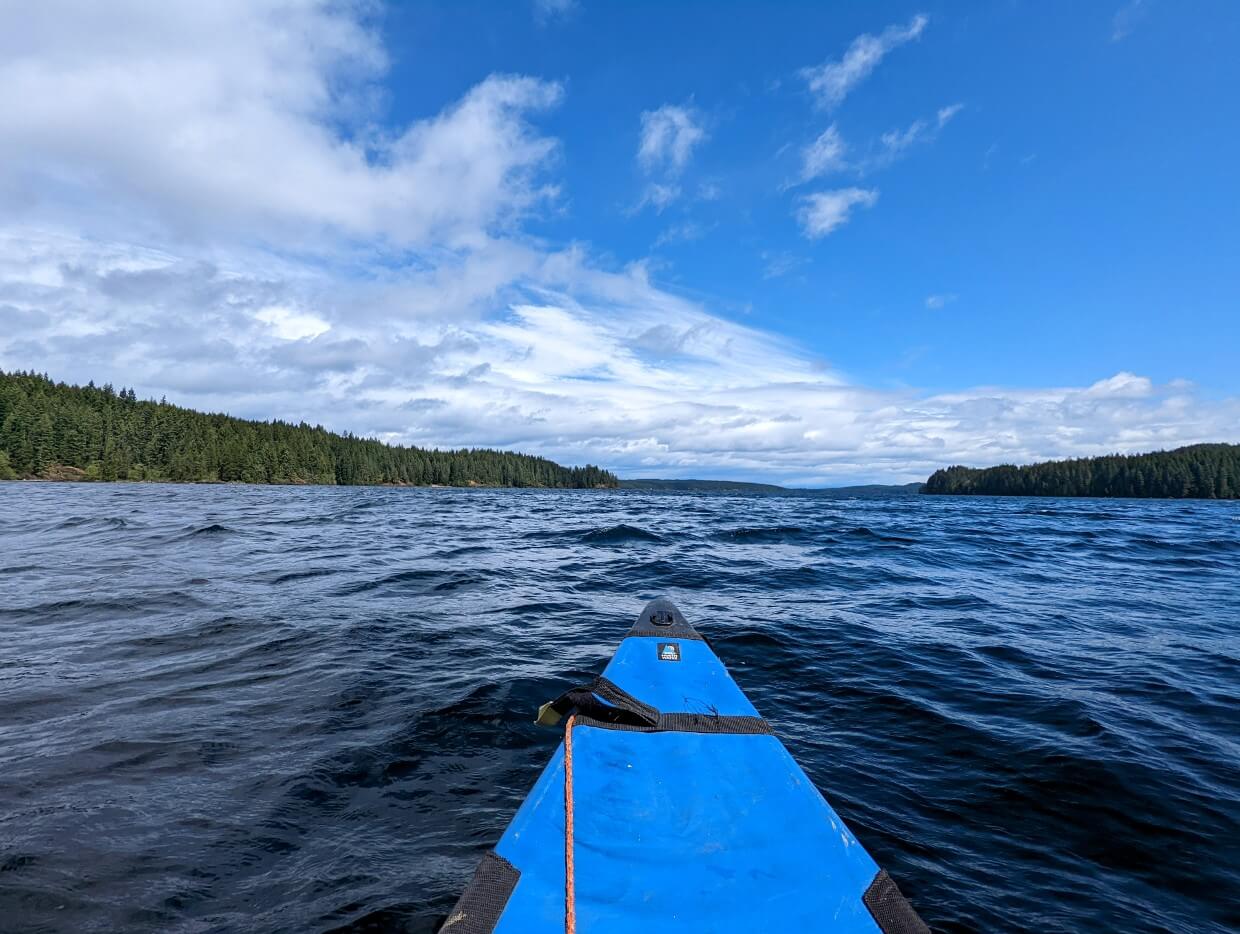
Large lakes
Wind can pick up quickly on the larger lakes such as Lower Campbell Lake, Mohun Lake and Brewster Lake.
Try to paddle these early and stay close to shore. On our last trip, the wind was in our favour on Brewster Lake but we still had to safely navigate metre high swells.
Lower Campbell Lake, Mohun Lake and Brewster Lake also attract a lot of boaters. Keep a close eye on them and make sure they have seen you (wearing your PFD at all times helps with visibility).
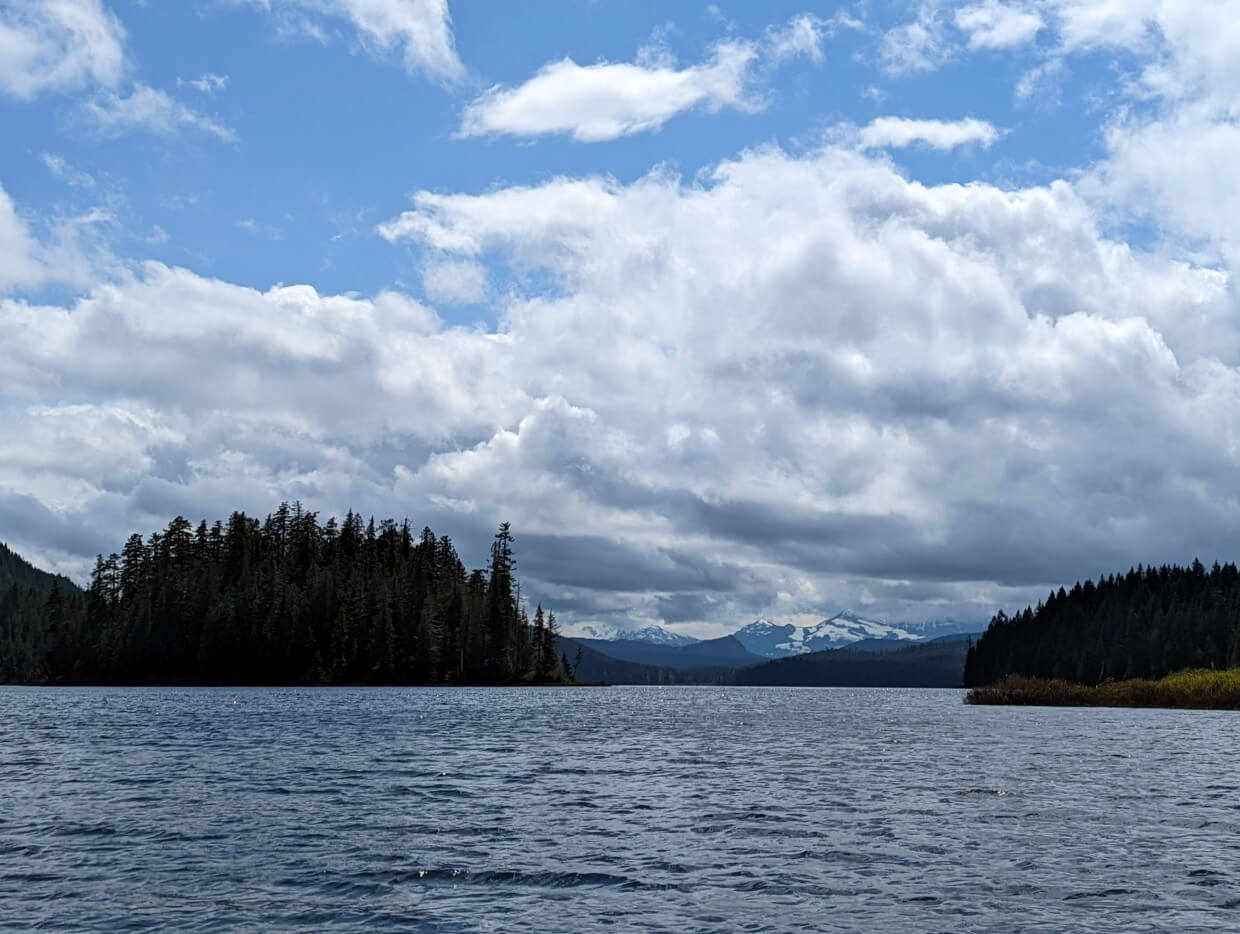
River sections
Whymper Creek connects Brewster Lake, Gray Lake, Whymper Lake and Fry Lake.
There are two mandatory river sections. There are also two portages around non-navigable sections with rapids. The latter are marked with large ‘WARNING’ signs on the right bank of the creek.
The first mandatory river section is located between Brewster Lake and Gray Lake. It requires some directional paddling to avoid larger rocks and some lining (walking with the canoe) on the shallower sections.
Even in mid May (high water level), we needed to get out and walk our canoe for 20m along the river to avoid rocks. It was pretty slippery underfoot and the current can be surprisingly fast. Attach at least one rope to your canoe and wear water shoes.
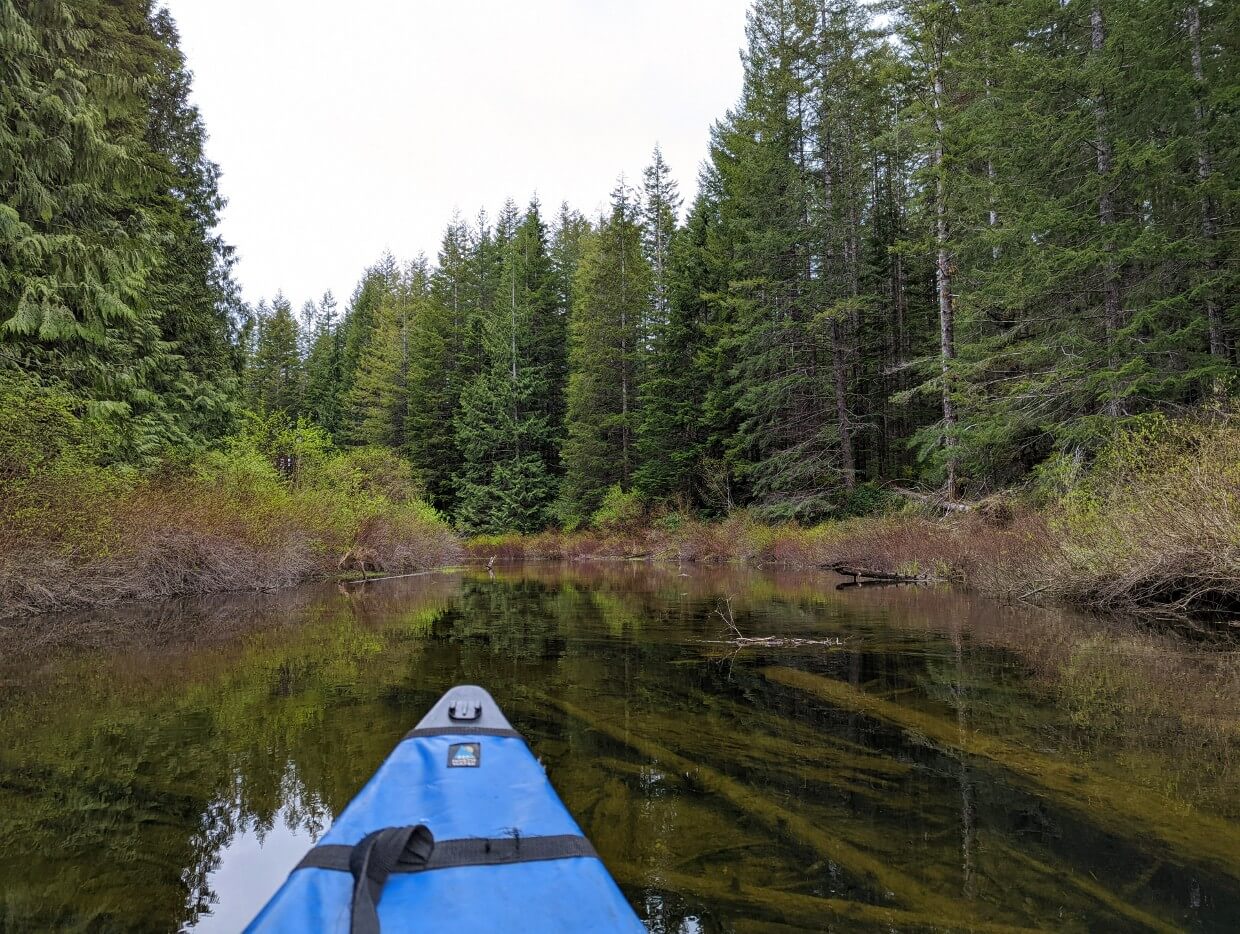
When the water level is low in summer, you may need to line your canoe for up to 300m.
The second river section is located between Gray Lake and Whymper Lake. The first part may also need to be lined during low water periods. Alternatively, there is a portage route (we’ve never used it).
The second half of this river section is narrow and fast. For the most part, the current will guide you through but some directional paddling may be needed.
There will be branches and plants blocking your way as you quickly move down the river. Consider wearing sunglasses to protect your eyes. We lost a hat here on our last paddle.
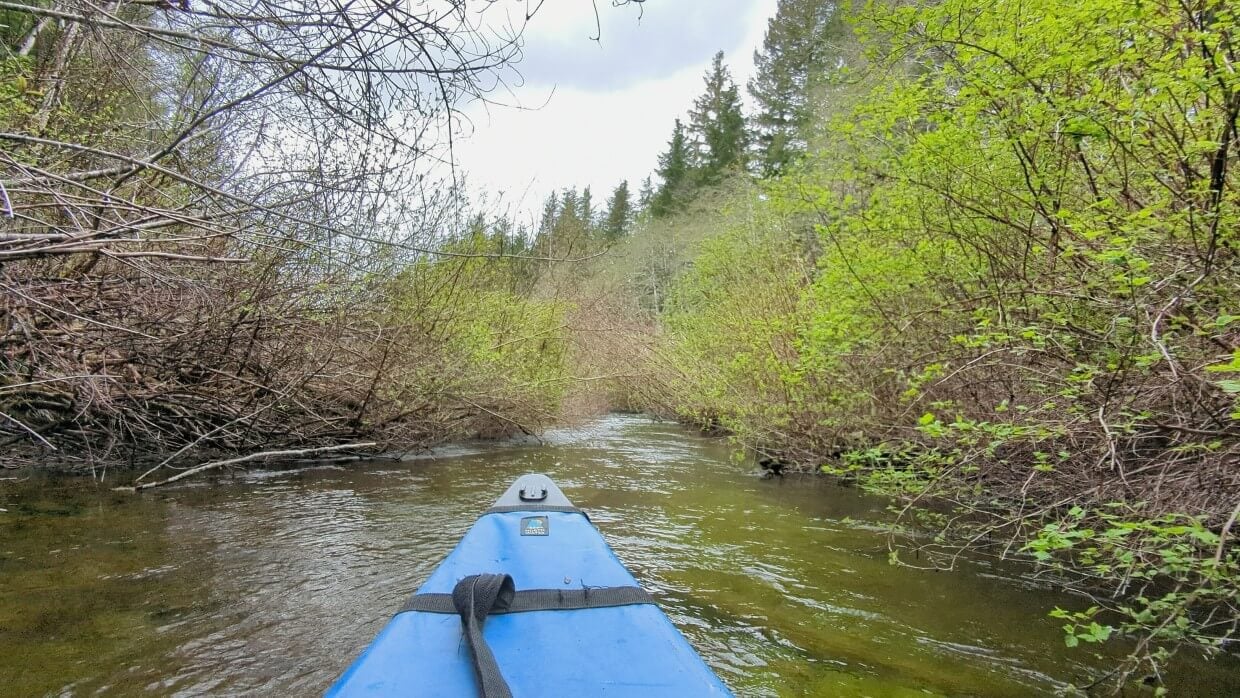
Essential items to bring
Here are a couple of items that we found to be useful for our trip on the Bowron Lakes Canoe Circuit in addition to all of our regular paddling gear:
- Sayward Forest Canoe Circuit by Michel Gauthier. This excellent guidebook is a great read before and during the adventure. Unfortunately, it is unavailable on most online bookstores right now (including Amazon). Some pages are visible on Google Books
- Sayward Forest Canoe Route brochure by Sites and Trails BC. This PDF features a map and information about the route
- Lightweight tarp – The perfect shelter for those Vancouver Island downpours. I personally wouldn’t paddle this circuit during the shoulder season without a lightweight tarp (we use the two person version of this Rab one)
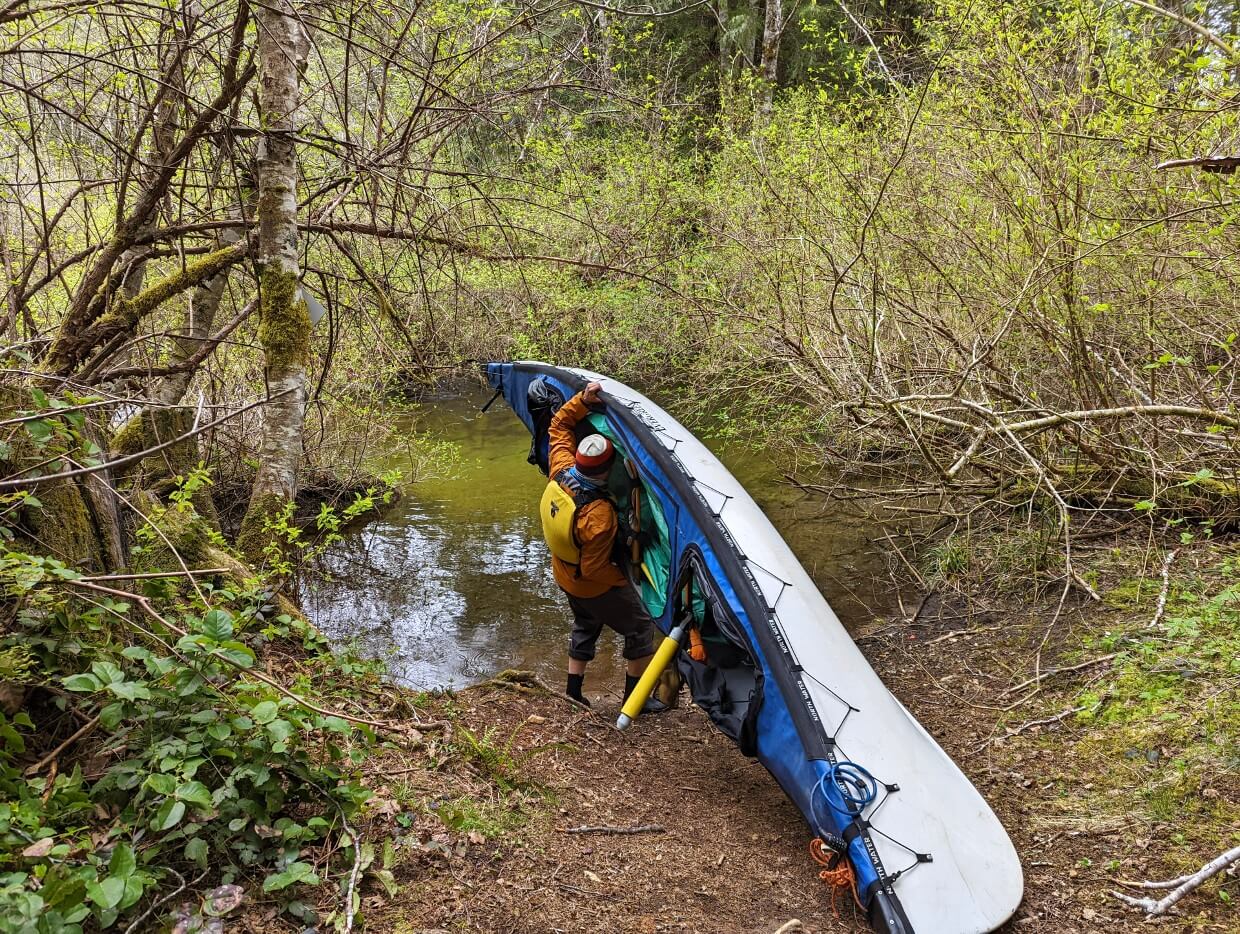
- Water treatment method – It is advisable to treat the water from any of the Sayward Forest lakes before drinking. We personally prefer to use a filter system while padding and at camp, but we always carry some Aquatabs as a lightweight backup
- Waterproof camera protection – You will definitely want your camera on the Sayward Canoe Route! We kept ours safe in a small Pelican case. Not only is it waterproof, the hard shell also protects our camera while packing and un-packing the canoe as well as during portages
- Toilet paper – Don’t expect to see toilet paper at any of the campsite toilets in the Sayward Forest. Bring your own!
- Water shoes – As mentioned above, you’ll likely need to line your canoe on Whymper Creek. Bring a pair of water shoes with toe coverage and grip. I use these MEC ones for canoe trips
- Fishing licence. Planning to fish while paddling the Sayward Forest Canoe Circuit? Make sure you have a printed copy of your valid BC freshwater fishing licence
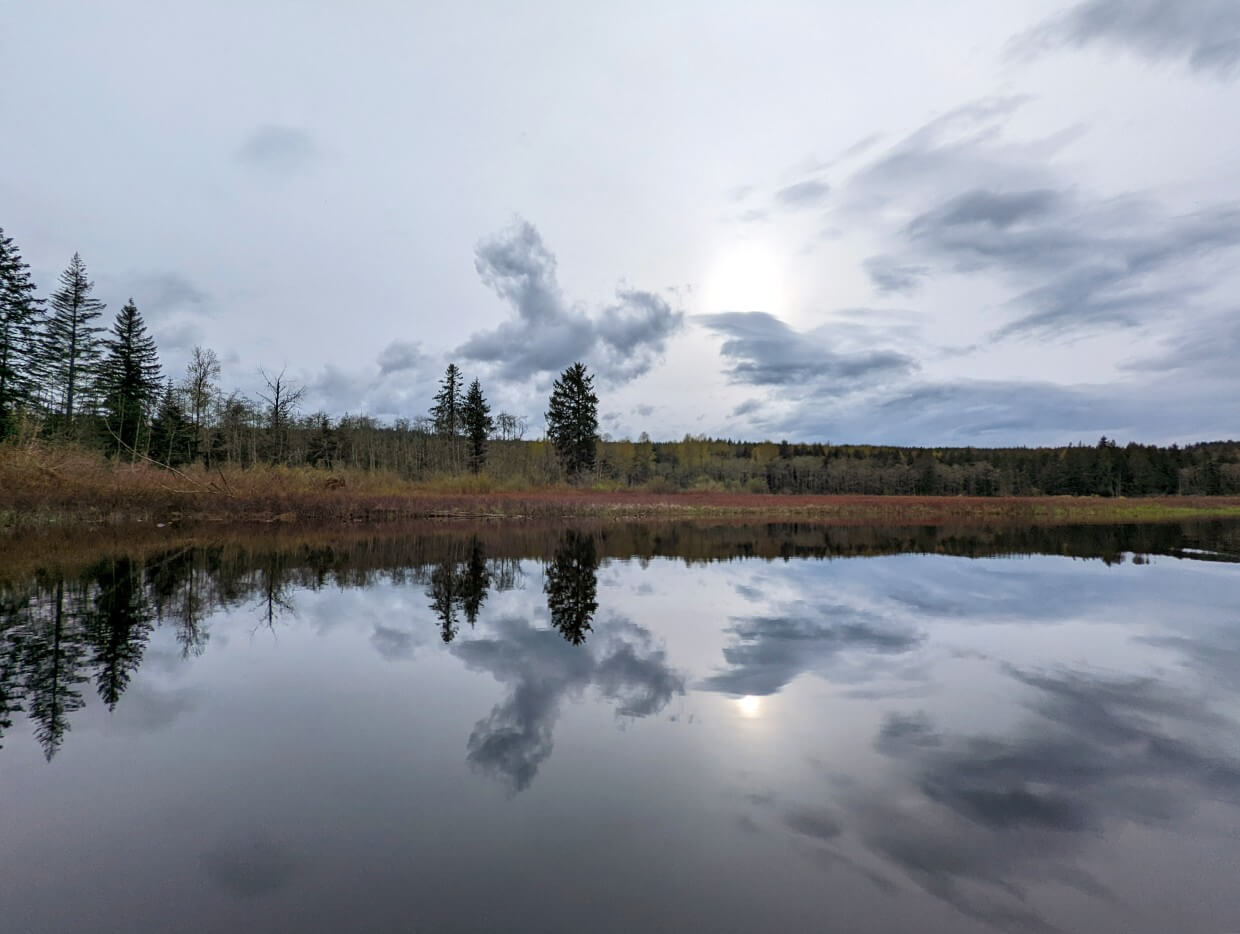
Novice paddler information
We paddled the Sayward Forest Canoe Circuit for the first time back in 2013, when we were pretty new at canoeing. It was also our first multi-day backcountry trip of any kind.
Paddling the Sayward Canoe Circuit turned out to be one our highlights of the year (and beyond), but there were challenging moments:
- We overpacked, having both way too much food AND gear. For this reason, we had to double portage, something that was very time consuming
- JR had decided he wanted to portage our 75lb canoe the traditional way. He did an amazing job but it was definitely physically harder than he had anticipated
- An almost full day of torrential rain dampened our spirits a little in the middle of the trip. This would be no issue with our experience now, but but then, it was tough
Despite these challenges, I would still wholeheartedly recommend the Sayward Forest Route to novice paddlers.

Novice paddler tips
- Some prior paddling experience is essential for the Sayward Forest Canoe Circuit
- Waves can build up fast on the larger lakes (Brewster, Lower Campbell and Mohun) and you need to know what to do if this happens
- Care and attention must also be paid to the two mandatory river sections on Whymper Creek (300m then 400m). More information here
- Be aware that some of the lakes are the result of dams. Fry Lake, in particular, has lots of deadheads (submerged logs or tree stumps). Paddle carefully!
- There may be beaver dams to cross, depending on how active the beavers have been. There is usually a beaver dam close to the entrance of Twin Lakes from the Small Ponds area

Where to stay before and after paddling the circuit
Campbell River is only 40 minutes away from Morton Lake Provincial Park, the most popular launching (and finishing) point for the Sayward Forest Canoe Circuit.
As a city of around 40k people, Campbell River has many of the services and amenities you may require before heading onto the Circuit.
As well as big box stores (Walmart, Superstore, Canadian Tire), there are some excellent specialist shops (River Sportsman, Tyee Marine Fishing)

Our favourite place to stay in the area is the Above Tide Motel. All of the well equipped rooms have a balcony with gorgeous views of the Salish Sea (keep an eye out for orcas!) It’s not a fancy place but the prices reflect that. There is a coin operated laundry as well.
Better still, Above Tide Motel is only a short walk away from the Discovery Pier and Dick’s Fish and Chips (the best post-Sayward reward!) Before leaving Campbell River, we like to stock up on seafood from Crabby Bob’s.
Located right on the docks, this family owned business has a great selection of local (and reasonably priced) seafood. There’s a little patio too if you want to try some steamed seafood right there and then!

Other paddling posts you may like:
17 of the Best Canoe Trips in British Columbia
Bowron Lake Canoe Circuit
Powell Forest Canoe Circuit
Okanagan Mountain Park
Murtle Lake
Clearwater and Azure Lakes
Desolation Sound Provincial Park
Maligne Lake, Jasper National Park
Algonquin Provincial Park, Ontario
Kejimkujik National Park, Nova Scotia


One half of the Canadian/British couple behind Off Track Travel, Gemma is happiest when hiking on the trail or planning the next big travel adventure. JR and Gemma are currently based in the beautiful Okanagan Valley, British Columbia, Canada. Consider buying us a coffee if you have find any of our guides helpful!

Hi there! I am hoping to do this route next week. Wondering what you did for food storage…are there bear cache’s at the sites, or did you hang the food? Thank in advance for your help!
Hi Talia,
There are no bear caches on the Sayward Route – at least, there wasn’t in 2013 and I can’t imagine any would have been added. We hung all of our food. Nowadays, we have a USack bag which is very difficult for bears and vermin to get into, but at the time we just used a large food bucket.
Have a great time!!
Thx for the info. Are there any kayakers out there who did all or part of the route? I am nervous about the portaging. Any hints on that aspect?
Hi Gemma,
Much enjoyed reading about your Quadra Island and Sayward trips. My wife and I and another couple are planning a week-long canoe trip in August. Other summers we have had more time and did the Stikine, Columbia, Bowron Lakes etc. but this time we are looking to do something closer to home (Victoria and Gabriola). We thought we might canoe for four or five days and then take the U-chuk to Kyuquot for our last couple days. Which of the two trips would you recommend? We love beautiful places and don’t mind a little hardship getting to them (but not too much!) For Sayward portages, do you recommend canoe carts with large wheels (the kind used on Bowron lakes)?
David
Hi David,
Thanks for your comment! Sayward Forest vs. Main Lake route….hmmm, they are different experiences. Quadra is a bit more of a ‘home base’ kind of trip (well, at least the way we did it), while Sayward is a far busier/adventurous kind of trip. Of course, you could adapt either trip e.g. stay in more than one campsite within the Main Lake area or stay at one lake for 2/3 nights on the Sayward route. Main Lake is a little quieter overall since you need a boat to get in there, while most of the campsites on Sayward are vehicle accessible. So it really depends what you’re looking for and your camping style. I would definitely recommend staying on Amor Lake on the Sayward route if you’re into quieter & more secluded places.
We’ve heard awesome things about the U-Chuck! I’m sure you’ll have a wonderful time whatever you choose to do. The one group of people we met on the Sayward route were using a canoe cart with large wheels (the Bowron type) and they were having no issues. There is only one portage which you can’t really use a cart due to tree routes and boulders.
Thanks, Gemma, for this information. I think this year it will be Quadra Island, 2 or three nights on Main Lake and other lakes in the area, and then paddle in the Surge Narrows and the Octopus Island group for a few more nights before heading to Kyuquot for the last couple nights.
Hope you have a wonderful summer.
Sounds like an amazing trip David! Hope you have a fantastic time!
Hi Gemma, in your article you state that the recommended direction is clockwise but all other sites say the opposite ie. do it in a counter clockwise direction. The official map also shows arrows to do it counterclockwise. Could you please clarify? Many thanks for your excellent article. Much appreciate the info. We are planning to leave early next week to spend 4 days on this route.
Hi Stuart,
Big typo on my part (must have been when I updated this post a few weeks ago) – you have to complete the circuit in a counter clockwise direction. This is due to the short river/creek sections. I’ve just fixed this. Have a fabulous time!
Hi Gemma,
I am thinking about doing this trip with a group of 10-12 people next summer. I would be coming from WA State. I could bring my canoe and rowing wherry with me on a small trailer over the ferry, but I will need another canoe or two depending. Any recommendation on an outfitter who could help with canoe rentals, etc.? Also, do you recommend canoe carts for the portages on this route?
Thanks,
Sam
Hi Sam, just copying what I emailed you previously –
Your trip sounds sounds awesome! I’m impresses you can get so many people together. If I were you, I wouldn’t rent canoes in Victoria as you still have a 4 hour drive from there. The closest place I know offhand is in the Comox Valley http://www.comoxvalleykayaks.com/rentals.html
For a group that big, I would really try and minimise the number of tents. I think you should also be prepared to split the group up for camping. Finally, I would avoid the island campsites with so many people as they are quite delicate environments.
As for carts – it really depends on how much gear you have and your ability to portage the traditional way. None of the portages have rests, something we found a bit tricky
Have a great trip!
Hi Gemma. Great info, thanks! We’re going to need to get from Brewster Lake Rec Site back to our truck at Mohun Lake where we will start. The comoxvalleykayaks rental place (thanks for that tip, by the way) can pick up their boats, etc, but not us. Any ideas/tips for us? THANKS!
Hey Kat, the only way I can think of is to walk along the logging road I’m afraid!
Hi Gemma and JR, this is Carrie, Australia Sophie’s “friend” from the WCT. I was part of the group of older women with Gary from Bliss. I came across this blog when I was doing some initial research into our trip for next year, possibly the Sayward Lakes Circuit! This is a great blog. Thank you for putting it together. Always nice to get a “layman’s” point of view!
So fun to hear from you Carrie! I’m glad you’ve found the website helpful. The Sayward Canoe Circuit is a fun adventure…though definitely less isolated than the West Coast Trail! Having said that, I was surprised how few people we saw in June when we completed it. Happy planning! You may also want to consider the Powell Forest Canoe Circuit. You could combine it with a hike on the Sunshine Coast Trail.
Hi Gemma,
Just wondering what your thoughts would be about kayaking the Sayward route in two single sea kayaks?
Thanks
Hi Diana,
I don’t see any major issues with using a kayak instead of a canoe. We used a kayak cart with our canoe the last time (not a canoe-specific expedition-style cart). The river sections will be the trickiest part (besides the general effort of portages) but that is the same for canoes. The Higgins Lake to Lawier Lake portage would require a carry since carts can’t really be used.
Please be advised that most Recreation sites along the route are now user pay. This includes Orchid meadows, Loon Bay, Dogwood Bay and others along the route. Site 14 @ Orchid meadows is closed to all tenants.
Hi John,
Yes, thanks for reminding me that more of the vehicle accessible Rec Sites now charge fees (a total of nine, all on the southern side). This means that there are still around 20 free sites along the route. I hope it stays that way! I think most Sayward paddlers head to the boat-in campsites anyway (I know we do).
HI Gemma
Love your article and I am getting ready for my first solo kayak trip on the Sayward Forest canoe route.
Stupid question, but fair to say that there is no drinking water access apart from the RV campsites? just gauging on how much water to carry and if my selection on campsites would be influenced by that.
Great info, you shared. Very much appreciated
Hi Andrea,
Great to hear you are planning a solo Sayward adventure!
For water, I wouldn’t carry much at all. Just use a filter, such as the BeFree, to purify the lake water. All campsites have lake access.
There are only a few drinking water taps in the area, specifically at Loveland Bay Provincial Park and Morton Lake Provincial Park (off the route).